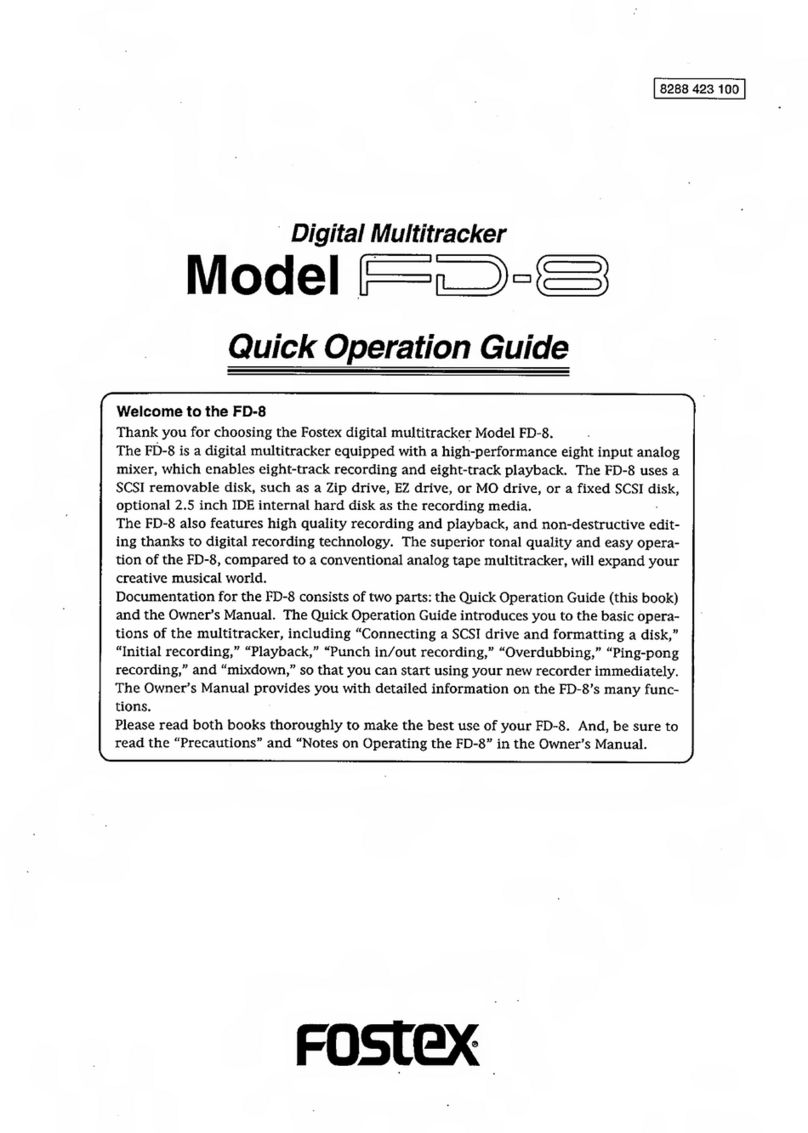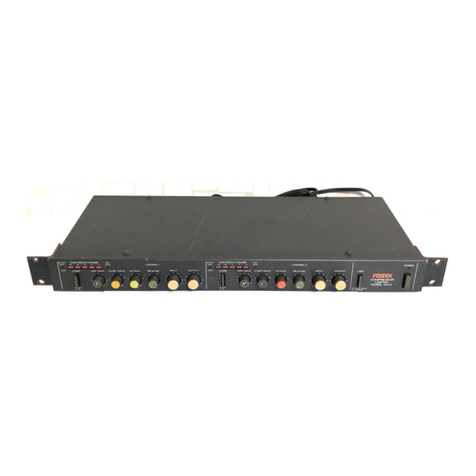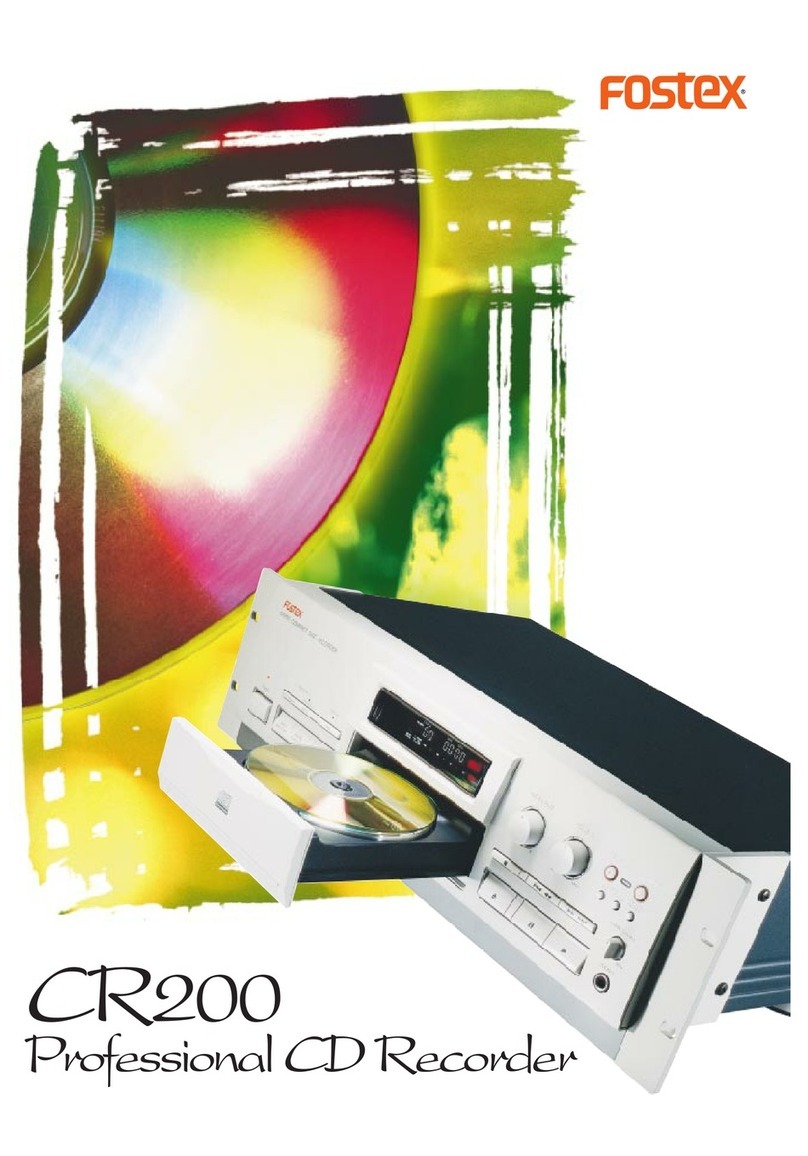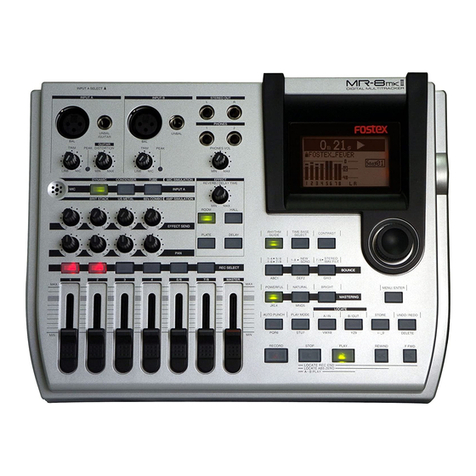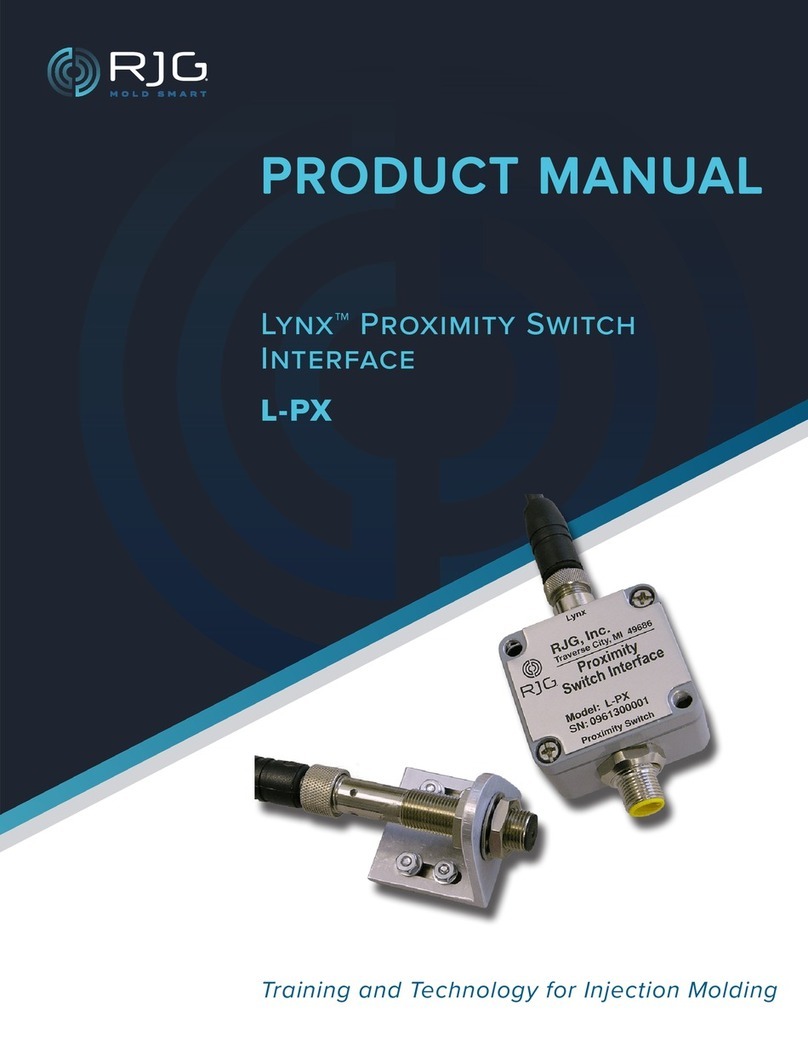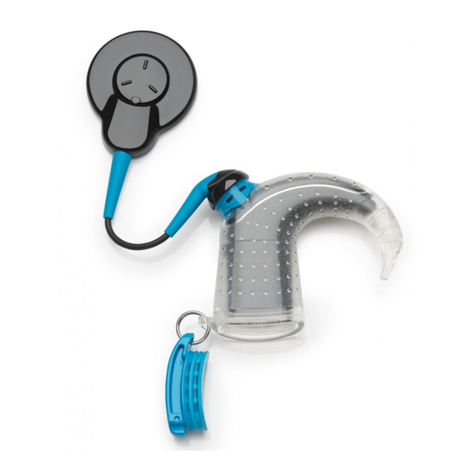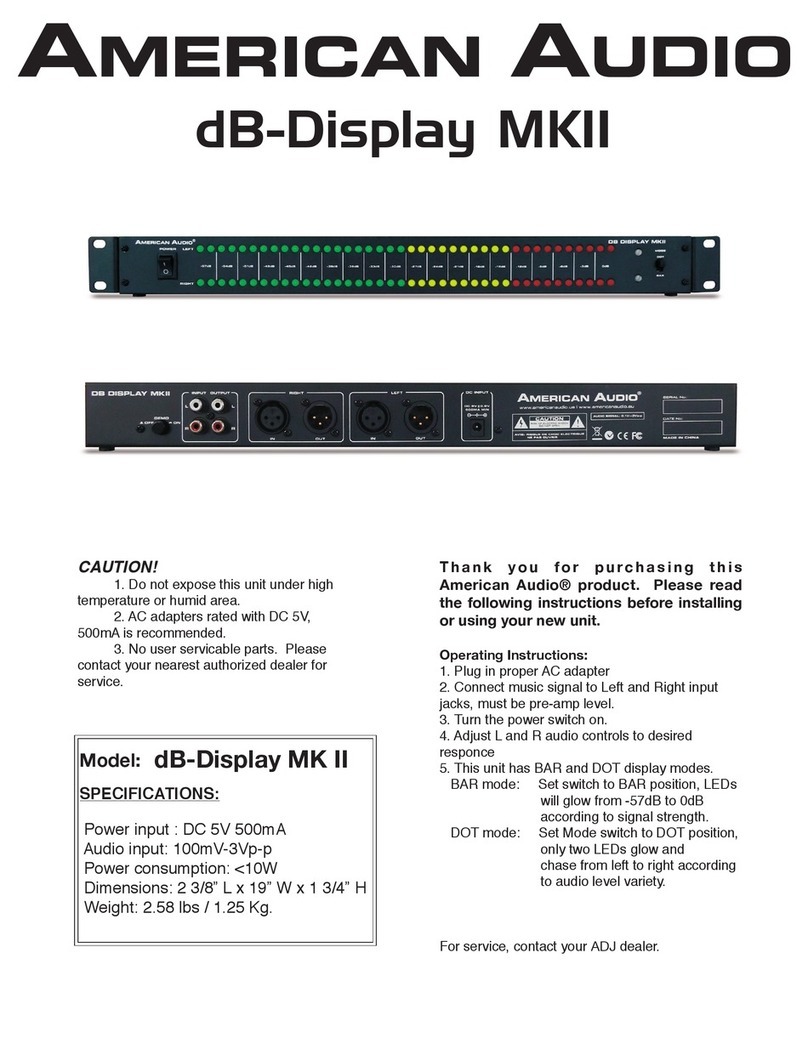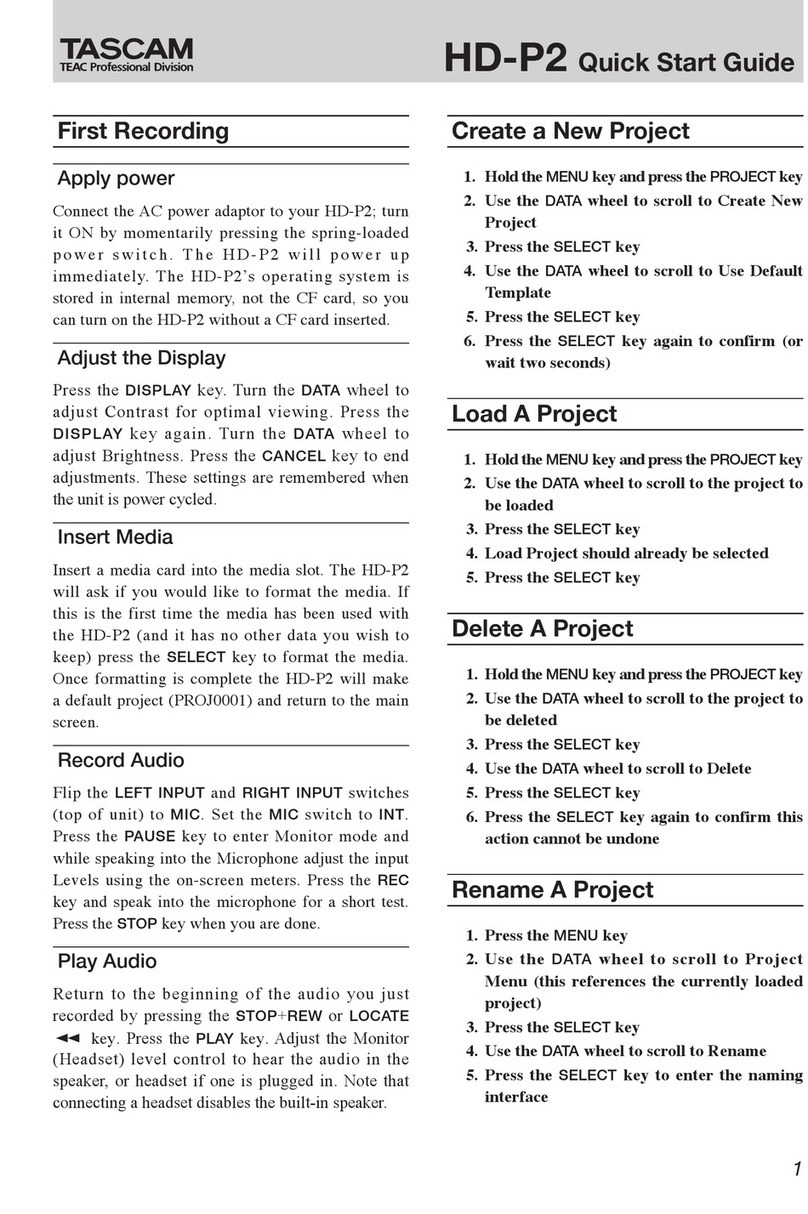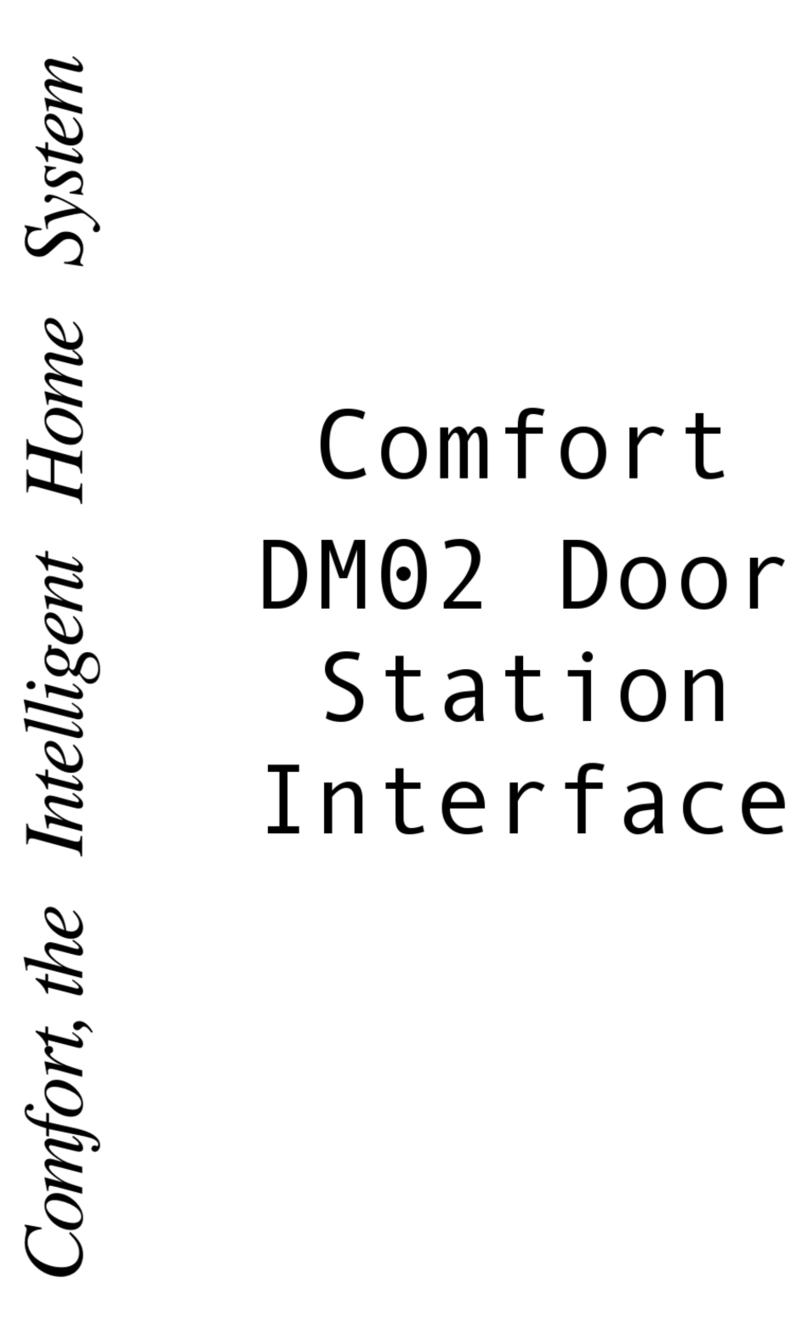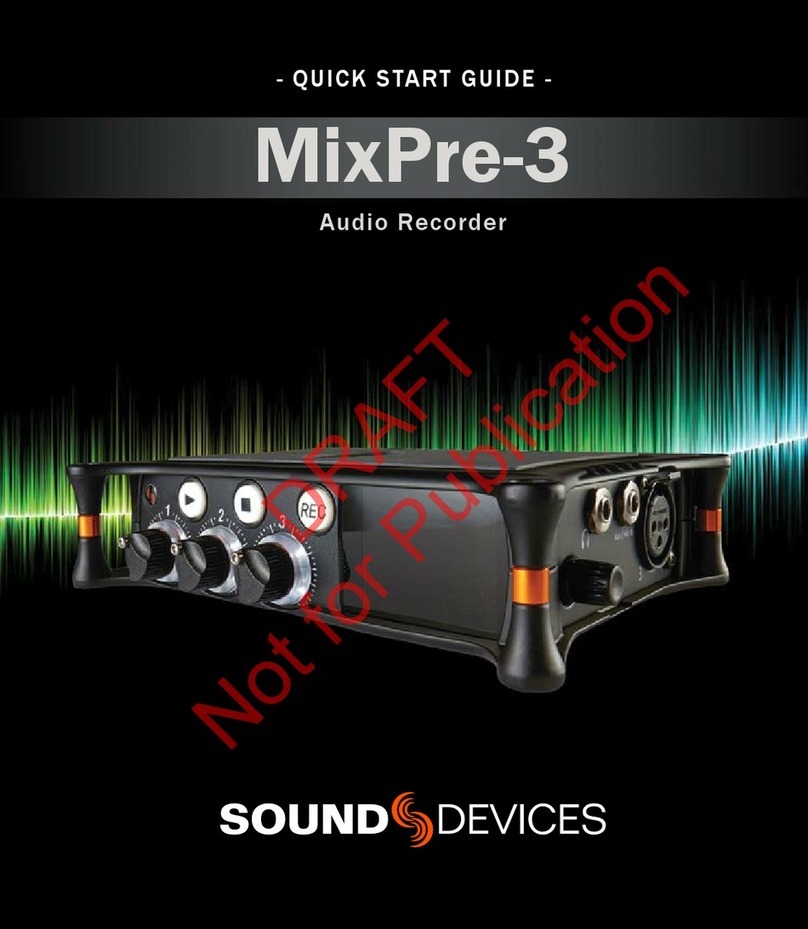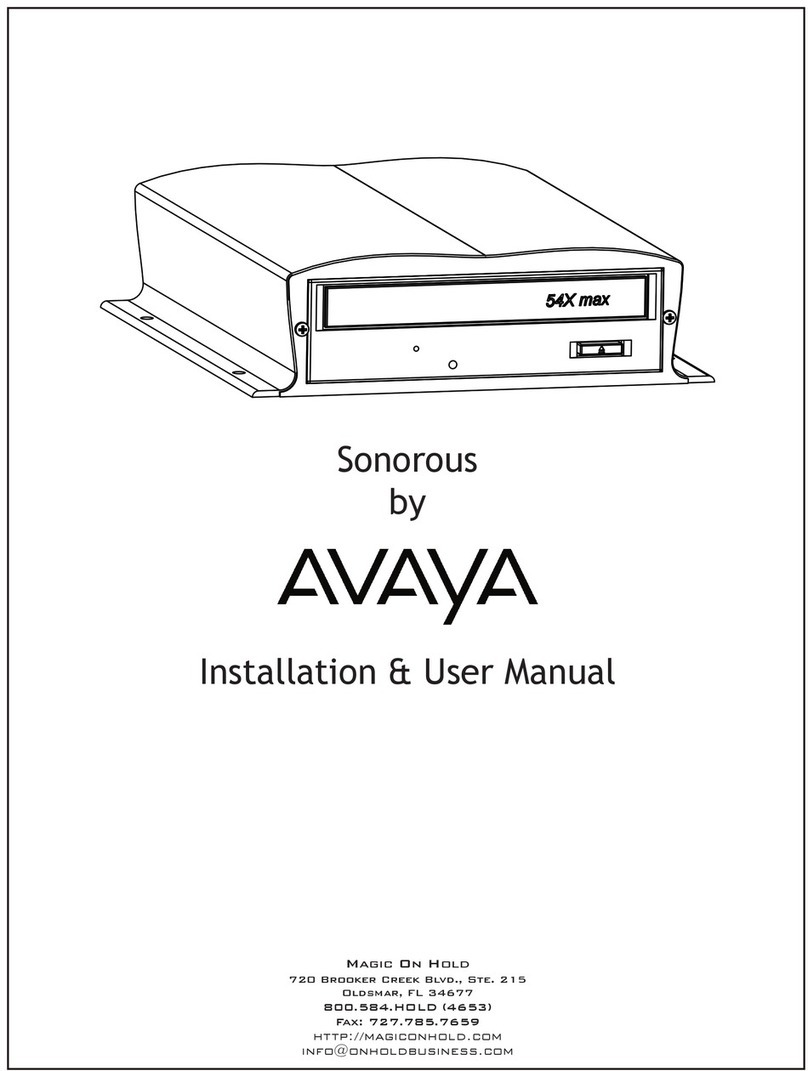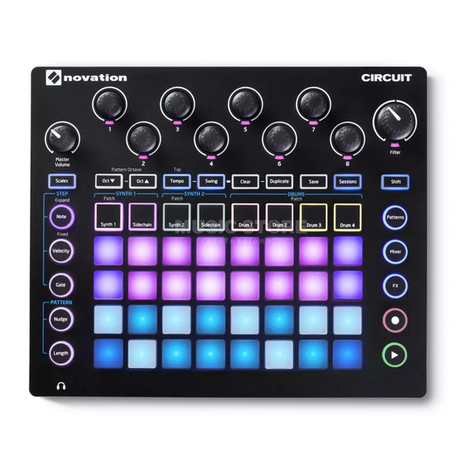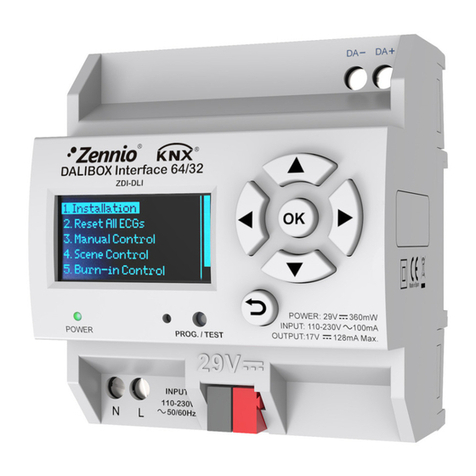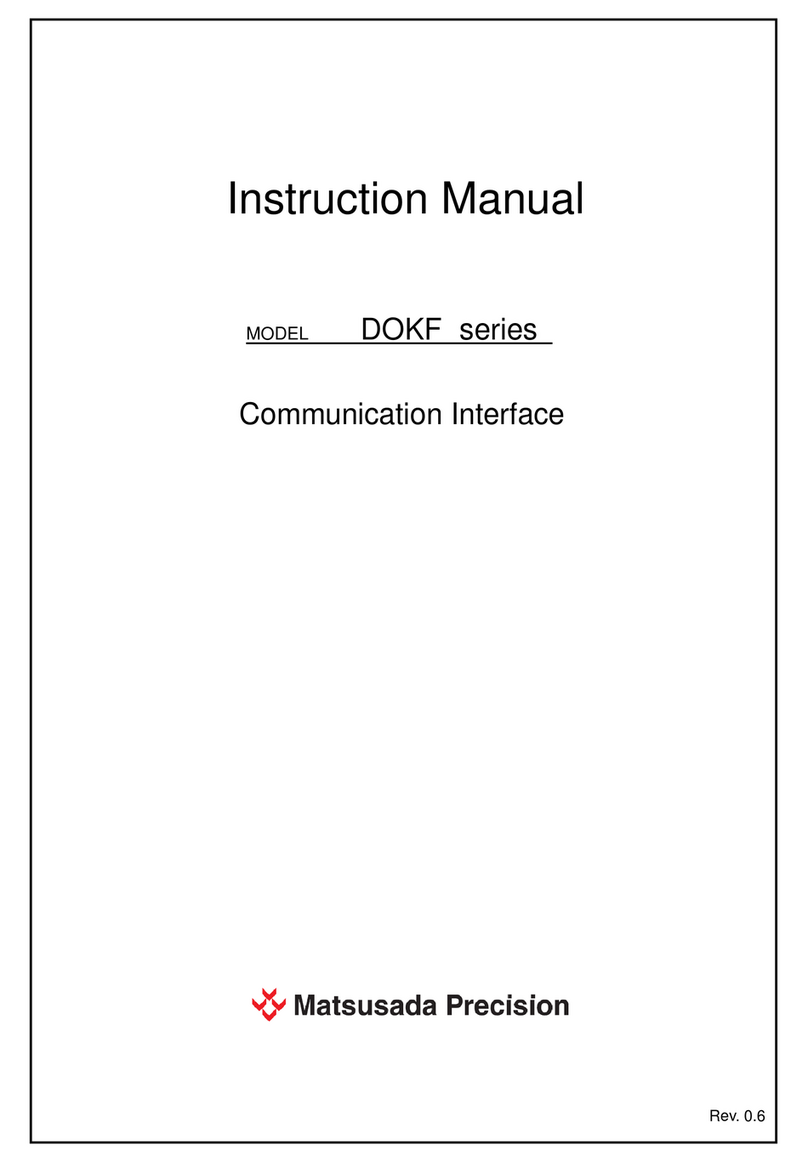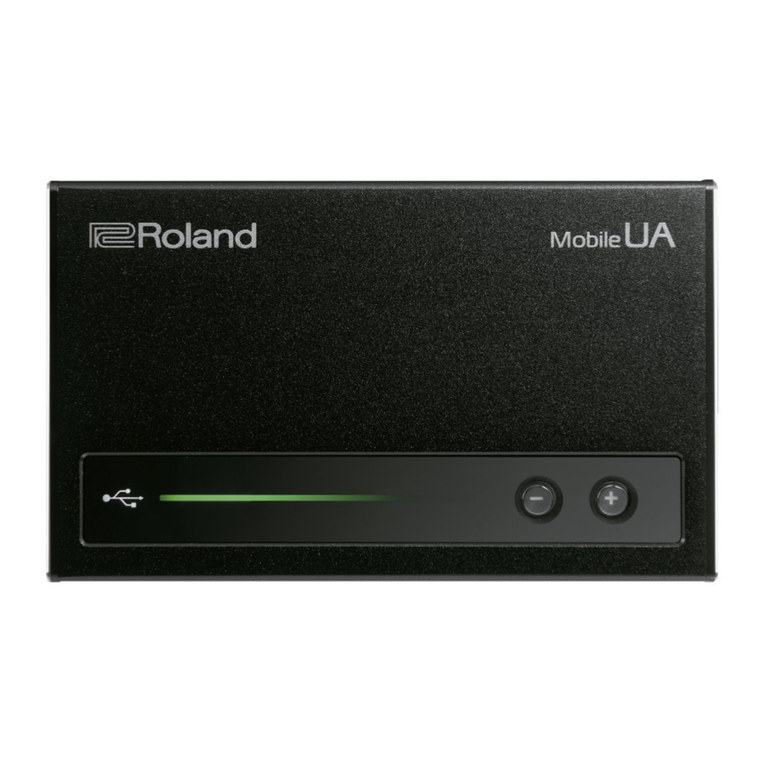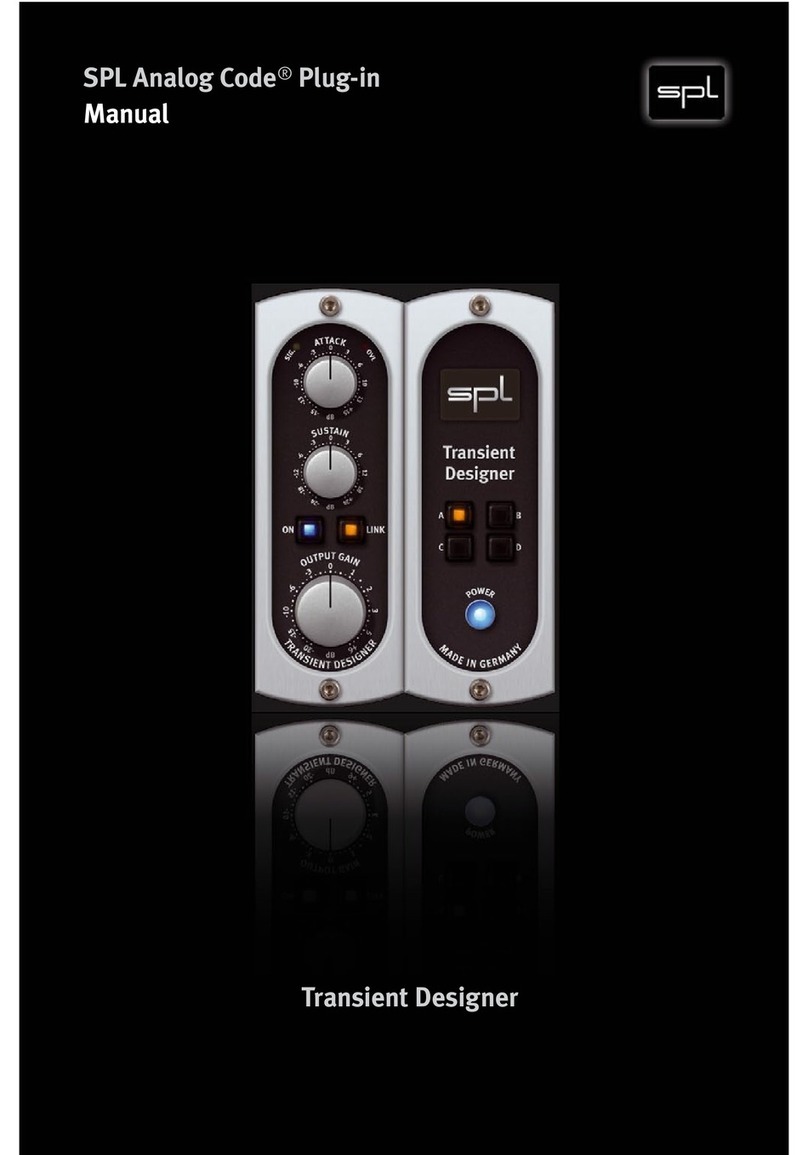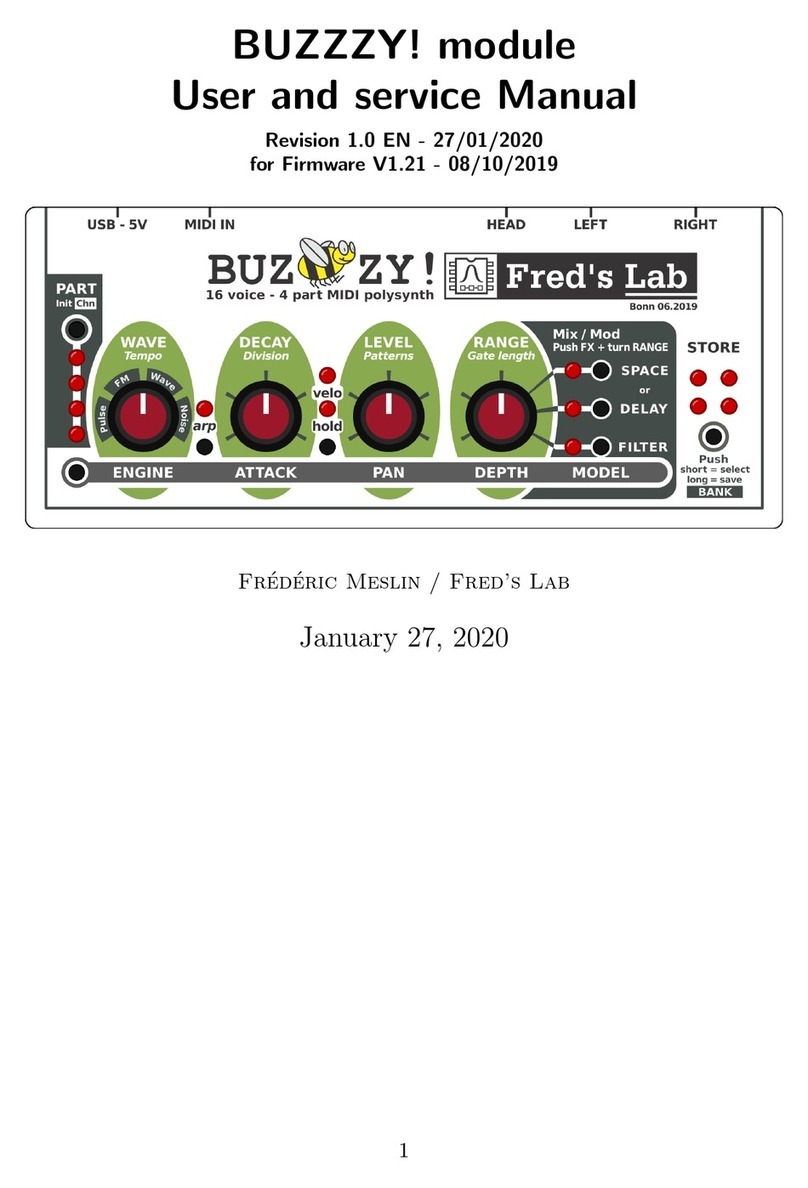Fostex FD-4 User manual

FD-4
Service Manual
Model
DIGITAL MULTITRACKER

SAFETY INSTRUCTIONS
Read instructions - All the safety and operating instruc-
tions should be read before the appliance is operated.
Retain instructions - The safety and operating instructions
should be retained for future reference.
Heed warnings - All warnings on the appliance and in the
operating instructions should be adhered to.
Follow instructions - All operating and use instructions
should be followed.
Water and Moisture - The appliance should not be used
near water - for example, near a bathtub, washbowl,
kitchen sink, laundry tub, in a wet basement, or near a
swimming pool, and the like.
Carts and Stands - The appliance should be used only
with a cart or stand that is recommended by the manufac-
turer.
An appliance and cart combination should be moved with
care. Quick stops, excessive force, and uneven surfaces
may cause the appliance and cart combination to over-
turn.
Wall or Ceiling Mounting - The appliance should be
mounted to a wall or ceiling only as recommended by the
manufacturer.
Ventilation - The appliance should be situated so that its
location or position does not interfere with its proper ven-
tilation. For example, the appliance should not be situ-
ated on a bed, sofa, rug, or similar surface that may block
the ventilation openings; or, placed in a built-in installa-
tion, such as a bookcase or cabinet that may impede the
flow of air through the ventilation openings.
Heat - The appliance should be situated away from heat
sources such as radiators, heat registers, stoves, or other
appliances (including amplifiers) that produce heat.
Power Sources - The appliance should be connected to a
power supply only of the type described in the operating
instructions or as marked on the appliance.
Grounding or Polarization - The precautions that should
be taken so that the grounding or polarization means of
an appliance is not defeated.
Power Cord Protection - Power supply cords should be
routed so that they are not likely to be walked on or
pinched by items placed upon or against them, paying
particular attention to cords at plugs, convenience recep-
tacles, and the point where they exit from the appliance.
Cleaning - The appliance should be cleaned only as rec-
ommended by the manufacturer.
Nonuse Periods - The power cord of the appliance should
be unplugged from the outlet when left unused for a long
period of time.
Object and Liquid Entry - Care should be taken so that
objects do not fall and liquids are not spilled into the en-
closure through openings.
Damage requiring Service - The appliance should be ser-
viced by qualified service personnel when:
A.
B.
C.
D.
E.
Servicing - The user should not attempt to service the ap-
pliance beyond that described in the operating instruc-
tions. All other servicing should be referred to qualified
service personnel.
REFER SERVICING TO QUALIFIED SERVICE PERSONNEL.
CAUTION
RISK OF ELECTRIC SHOCK
DO NOT OPEN
CAUTION: TO REDUCE THE RISK OF ELECTRIC SHOCK,
DO NOT REMOVE COVER (OR BACK).
NO USER-SERVICEABLE PARTS INSIDE.
TO PREVENT ELECTRIC SHOCK, MATCH
WIDE BLADE OF PLUG TO WIDE SOLT,
FULLY INSERT.
POUR ÉVITER LES CHOCS ÉLECTRIQUES,
INTRODUIRE LA LAME LA PLUS LARGE DE
LA FICHE DANS LA BORNE CORRE-
SPONDANTE DE LA PRISE ET POUSSER
JUSQU' AU FOND.
CAUTION:
ATTENTION:
The exclamation point within an equilateral
triangle is intended to alert the user to the
presence of important operating and mainte-
nance (servicing) instructions in the literature
accompanying the appliance.
The lightening flash with arrowhead symbol,
within an equilateral triangle, is intended to
alert the user to the presence of uninsulated
“dangerous voltage” within the product's en-
closure that may be of sufficient magnitude to
constitute a risk of electric shock to persons.
“WARNING”
“TO REDUCE THE RISK OF FIRE OR ELECTRIC SHOCK,
DO NOT EXPOSE THIS APPLIANCE TO RAIN OR MOIS-
TURE.”
1.
2.
3.
4.
5.
6.
7.
8.
The power supply cord or the plug has been damaged;
or
Objects have fallen, or liquid has been spilled into the
appliance; or
The appliance has been exposed to rain; or
The appliance does not appear to operate normally or
exhibits a marked changed in performance; or
The appliance has been dropped, or the enclosure
damaged.
9.
10.
11.
12.
13.
14.
15.
16.
17.

Parts marked with this sign are safety critical components. They must always be replaced with identical
components. Refer to the Fostex Parts List and ensure exact replacement.
CAUTION
TABLE OF CONTENTS
1. SPECIFICATIONS . . . . . . . . . . . . . . . . . . . . . . . . . . . . . . . . . .
2. CONTROLS, INDICATORS AND CONNECTORS . . . . . . . . . . .
3. SOFTWARE UPDATE . . . . . . . . . . . . . . . . . . . . . . . . . . . .
4. SERVICE MODE . . . . . . . . . . . . . . . . . . . . . . . . . . . . . . . . . . .
5. ERROR CODE LIST . . . . . . . . . . . . . . . . . . . . . . . . . . . . . . . .
6. INSTALLING 2.5" INTERNAL HARD DISK DRIVE . . . . . . . . .
7. EXPLODED VIEW, PCB ASSEMBLY AND PARTS LIST . . . . .
8. CIRCUIT DIAGRAMS . . . . . . . . . . . . . . . . . . . . . . . . . . . . .
Owner's manual : 8288414100 (for export model)
: 8288415000 (for domestic model)
Service mode, error code list, explode view, PCB assembly, parts list and circuit diagrams are given in this
manual to assist the service technician in maintaining the Model FD-4.
NOTES
The following accessories are supplied with FD-4 as the standard accessories.
*
*
Following is the packing material for the Model FD-4.
*
Carton, inner, FD-4 : 8228716000
Packing, side, L, FD-4 : 8228440000
Packing, side, R, FD-4 : 8228441000
FD-4
4
7
11
12
19
20
24
41
!
FD-4
3

4
FD-4
1. SPECIFICATIONS
RECORD & REPRODUCE
Recording Medium External fixed / removable hard disk drive
Standard SCSI-2 or better
Sampling Frequency 32 kHz, 44.1 kHz
Quantization 12-bit nonlinear, 16-bit linear
Emphasis Not available
Recording Time (mono track min.)
Fs: 32 kHz About 33 min. / 100 MB (up to 24 hours) at maximum
Fs: 44.1 kHz About 18 min. / 100 MB (up to 24 hours) at maximum
Number of Tracks
NORMAL / MASTERING MODE 1 6 (4 + 2 additional tracks)
MASTERING MODE 2 4
Number of simultaneous recording tracks 2
Number of simultaneous playback tracks 4
Number of tracks to be pasted at a time 6
Recording Format FDMS-3
Recording Mode NORMAL MODE (Fs: 32 kHz, 4 + 2 tracks, default)
MASTERING MODE 1 (Fs: 44.1 kHz, 4 + 2 tracks)
MASTERING MODE 2 (Fs: 44.1 kHz, 4 tracks)
ELECTRICAL (0 dBV = 1 V)
• MIXER SECTION
Reference Input Level
MIC -50, -30 dBV
Impedance 20 kΩor more
LINE -10 dBV
Impedance 20 kΩor more
RECORDER IN -10 dBV
Impedance 20 kΩor more
AUX RTN -20 dBV
Impedance 8 kΩor more
DATA IN
Connector Square shape optical
Format IEC consumer optical standard IEC 958 Part 3
Reference Output Level
STEREO -10 dBV
Load impedance 10 kΩor more
AUX SEND -10 dBV
Load Impedance 10 kΩor more
MONITOR -10 dBV
Load impedance 10 kΩor more
HEADPHONE 20 mW at maximum (Load: 16 Ω)
50 mW at maximum (Load: 50 Ω)
DATA OUT
Connector Square shape optical
Format IEC consumer optical standard IEC 958 Part 3

FD-4
5
ELECTRICAL (continued)
SCSI DATA input / output
Connector D-SUB 25-pin
Protocol SCSI-2, unbalanced transfer method
Transfer type Asynchronous
Number of device to be connected 1
Fader / Knob Position at Reference Input / Output
MASTER fader At 8 ~ 9 position (AUX RTN : -20 dBV / 1 kHz, AUX RTN
VR: MAX. Adjust master fader for -10 dBV output at
STEREO OUT.)
MONITOR knob Adjust MONITOR knob for -10 dBV output at MONITOR
OUTPUT. (MON SEL: ST+MON, MON)
INPUT fader At 7 ~ 8 position (INPUT: -10 dBV / 1 kHz, EQ GAIN: 0,
PAN: L (R). Adjust input fader for -10 dBV output at
STEREO OUT.)
Output Level
INPUT (1 ~ 4) →→
→→
→AUX SEND -10 dBV +0, -2 dB (INPUT: -10 dBV / 1 kHz, EQ GAIN:
0, PAN: L (R), AUX1, 2 VR: CH MAX, input fader: at 7 ~
8 position.)
INPUT (1 ~ 4) →→
→→
→MONITOR -10 dBV ± 1 dB (INPUT: -10 dBV / 1 kHz, EQ GAIN: 0,
PAN: L (R), MON VR: MON MAX, MON PAN: L (R),
input fader: at 7 ~ 8 position.)
Frequency Response
INPUT (1 ~ 4) →→
→→
→MONITOR 20 ~ 20 kHz +1, -3 dB (INPUT: -50 dBV)
20 ~ 20 kHz +1, -2 dB (INPUT: -10 dBV)
INPUT (1 ~ 4) →→
→→
→AUX SEND 20 ~ 20 kHz +1, -2 dB (INPUT: -10 dBV)
AUX RTN →→
→→
→MONITOR OUT 20 ~ 20 kHz +1, -2 dB (AUX RTN: -20 dBV)
AUX RTN →→
→→
→PHONES 80 ~ 20 kHz +1, -2 dB (AUX RTN: -20 dBV, at 20 mW /
16 Ω)
EQ Characteristics
High (12 kHz) & Low (80 Hz) +15 dB ± 3 dB at “+15” position
-15 dB ± 3 dB at “-15” position
Mid (200 Hz ~ 5 kHz) +15 dB ± 3 dB at “+15” position
-15 dB ± 3 dB at “-15” position
S / N
INPUT
INPUT Σ4
Residual Noise
-50 dBV
-38 dBV
-10 dBV
+2 dBV
-50 dBV
-38 dBV
-10 dBV
+2 dBV
VR MIN
AUX SEND
AUX SEND
AUX SEND
AUX SEND
MONITOR
MONITOR
MONITOR
MONITOR
PHONES
-10 dBV
+2 dBV
-10 dBV
+2 dBV
-10 dBV
+2 dBV
-10 dBV
+2 dBV
66 dB or more
78 dB or more
80 dB or more
92 dB or more
63 dB or more
75 dB or more
73 dB or more
85 dB or more
68 dB or more
80 dB or more
82 dB or more
94 dB or more
65 dB or more
77 dB or more
75 dB or more
87 dB or more
-75 dBV or less
LEVEL LEVEL UNWTD. AWTD.
INPUT OUTPUT S / N

6
FD-4
ELECTRICAL (continued)
Distortion
Crosstalk 60 dB or more / 1 kHz
Click Noise
Power on / off -20 dBV p-p or less
Other switching -50 dBV p-p or less
MIDI Controlling Operation check should be executed using the test mode
with connecting the MIDI IN and OUT terminal.
• RECORDER SECTION
Frequency Response
Fs: 44.1 kHz 20 ~ 20 kHz +1, -2 dB
Fs: 32 kHz 20 ~ 14.5 kHz +1, -2 dB
Full Scale Output Level (Ref: -12dB) +2 dBV ± 1 dB (Fs: 32 kHz / 44.1 kHz)
Dynamic Range 88 dB or more (Fs: 32 kHz / 44.1 kHz)
Total Harmonic Distortion
Fs: 44.1 kHz 0.02 % or less
Fs: 32 kHz 0.08 % or less
Channel Separation 80 dB or more / 1 kHz at max. recording level
(Fs: 32 kHz / 44.1 kHz)
S / N 88 dB or more (A-WTD., Fs: 32 kHz / 44.1 kHz)
Power Consumption
JPN 13 W +5, -20 %
Others 15 W +5, -20 %
Specifications and appearance are subject to change without notice for product improvement.
INPUT
AUX RTN
-40 dBV
0 dBV
0 dBV
-10 dBV
-10 dBV
MONITOR
MONITOR
AUX SEND
MONITOR
PHONES
0 dBV
0 dBV
0 dBV
0 dBV
20 mW
100 ~ 10 kHz
100 ~ 10 kHz
100 ~ 10 kHz
100 ~ 10 kHz
1 kHz
0.05 % or less
0.05 % or less
0.05 % or less
0.05 % or less
0.10 % or less
LEVEL LEVEL UNWTD. AWTD.
INPUT OUTPUT S / N

FD-4
7
2. CONTROLS, INDICATORS & CONNECTORS
4
3
21
INPUT 3
R MON OUT L R ST OUT L AUX RTN 1
R MONO/L
AUX RTN 2
R MONO/L
2 AUX SEND 1 4 INSERT 3
INPUT 4
SCSI OUTIN DATA R
RECORDER IN
LIN MIDI
OUT
PUNCH
IN/OUT
DATA MIDI
POWER
Rear Panel
Control Panel
Front Panel
MON L MON R
MON L MON R
MON L MON RMON L MON R
0000
0000
0
0
0
0
0
0
0
0
0
0
00
UNDO/
PUNCH
AUTO
LEVEL LEVEL
MASTER
010
2
010
1
010
SELECTOR
PAN
LOW
HIGH
GAIN
MID
AUX1
-
-
-
AUX2
+
+
+
TRK4INPUT
R
L
PAN
LOW
HIGH
GAIN
MID
AUX1
-
-
-
AUX2
+
+
+
TRK3INPUT
R
L
PAN
LOW
HIGH
GAIN
MID
AUX1
-
-
-
AUX2
+
+
+
TRK2INPUT
R
L
PAN
LOW
HIGH
2k
900
300
GAIN
MID
SHIFT
AUX1
-
-
200
-
AUX2
+
+
5k
+
TRK1INPUT
0
10
5
L/R+MON
L/R
MON
OFF
INPUT
TRK 4
OFF
INPUT
TRK 3
OFF
INPUT
TRK 2
OFF
PITCH
VARI
MID
RL
SHIFT
4/R3/L2/R
SELDISP SEL
R
L
DIGITAL MULTITRACKER
1/L
INPUT
TRK 1 CLIPBOARD PLAY
LOCATE ABS 0
LOCATE REC END F FWD/REWIND/PLAYSTOP
RECORD
REDOEDIT
START IN OUT
AUTO PLAY
EXECUTE
/YES EXIT
/NO
HOLD/ STORE
END IN OUT
PGM SEL
AUTO RTN
SETUP
H
M
L
H
M
L
TIME BASE
ACCESS
2k
900
300
SHIFT
200 5k
MID
2k
900
300
SHIFT
200 5k
MID
2k
900
300
SHIFT
200 5k
MID
AUX AUX AUX AUX AUX RTN
EQ
EQ
EQ
EQ
MON MON MON MON
PAN PAN PAN PAN
INPUT SELINPUT SEL INPUT SEL INPUT SEL
12 3 4L/R
MON SECTION
CLIPBOARD
AUTO PUNCH
AUTO RTN
ADD.TRACK
PREVIEW
RECORDTRACK
P. EDIT SHUTTLE
JOG
EJECT
LOC MEM
LOCATE
0
10
5
0
10
5
0
10
5
0
10
5

8
FD-4
Control Panel (Mixer Section)
MON L MON R
MON L MON R
MON L MON RMON L MON R
0000
0000
0
0
0
0
0
0
0
0
0
0
00
LEVEL LEVEL
MASTER
010
2
010
1
010
SELECTOR
PAN
LOW
HIGH
GAIN
MID
AUX1
-
-
-
AUX2
+
+
+
TRK4INPUT
R
L
PAN
LOW
HIGH
GAIN
MID
AUX1
-
-
-
AUX2
+
+
+
TRK3INPUT
R
L
PAN
LOW
HIGH
GAIN
MID
AUX1
-
-
-
AUX2
+
+
+
TRK2INPUT
R
L
PAN
LOW
HIGH
2k
900
300
GAIN
MID
SHIFT
AUX1
-
-
200
-
AUX2
+
+
5k
+
TRK1INPUT
0
10
5
L/R+MON
L/R
MON
OFF
INPUT
TRK 4
OFF
INPUT
TRK 3
OFF
INPUT
TRK 2
OFF
MID
R
L
INPUT
TRK 1
H
M
L
H
M
L
2k
900
300
SHIFT
200 5k
MID
2k
900
300
SHIFT
200 5k
MID
2k
900
300
SHIFT
200 5k
MID
AUX AUX AUX AUX AUX RTN
EQ
EQ
EQ
EQ
MON MON MON MON
PAN PAN PAN PAN
INPUT SELINPUT SEL INPUT SEL INPUT SEL
12 3 4L/R
MON SECTION
0
10
5
0
10
5
0
10
5
0
10
5
1. Input faders [1-4]
2. Input select switches
[INPUT SEL (INPUT/OFF/TRK)]
3. Panpot knobs [PAN (L/R)]
4. Monitor panpot knobs [PAN (MON L/MON R)]
5. Monitor level control knob [MON (INPUT/TRK)]
6. Equalizer control knobs [EQ (HIGH/MID/LOW)]
7. AUX send knobs [AUX (AUX 1/AUX 2)]
8. AUX return knobs [AUX RTN (1, 2)]
9. Monitor master knob
[MONITOR SECTION (MASTER)]
10. Monitor select switch
[SELECTOR (L/R, L/R+MON, MON)]
11. Master fader [L/R]
12. Input level switches [LEVEL (H/M/L)]
1
2
3
4
5
7
6
8
9
10
11
12
12

FD-4
9
13. Record track select keys
[RECORD TRACK (1/L, 2/R, 3/L, 4/R, L, R)]
14. LCD
15. Contrast adjustment knob
16. Display indication select key
17. Setup key [SETUP]
18. Time Base select key
19. Execute/Yes key [EXECUTE/YES]
20. Exit/No key [EXIT/NO/ EJECT ]
21. Access LED [ACCESS]
22. JOG dial [JOG/ SHUTTLE ]
23. Fast forward button [F FWD/ ]
24. Rewind button [REWIND/ ]
25. Play button [PLAY]
26. Stop button [STOP]
27. Record button [RECORD/ AUTO PUNCH ]
28. Shift key [ SHIFT ]
29. Vari Pitch key [VARI PITCH/ P.EDIT ]
30. Auto Return/Auto Play mode on/off key
[AUTO RTN/AUTO PLAY]
31. Locate key [LOCATE/ LOC MEM ]
32. Hold/ key [HOLD/ ]
33. Store key [STORE]
34. Undo/Redo key [UNDO/REDO]
35. Edit key [EDIT]
36. Auto Return Start key [AUTO RTN START/ PREVIEW ]
37. Auto Return End key [AUTO RTN END/ PREVIEW ]
38. Auto Punch In key [AUTO PUNCH IN/ PREVIEW ]
39. Auto Punch Out key [AUTO PUNCH OUT/ PREVIEW ]
40. Clipboard In key [CLIPBOARD IN/ PREVIEW ]
41. Clipboard Out key [CLIPBOARD OUT/ PREVIEW ]
26
27
28
29
30
31
32
35
33
34 36
38 39
37
13
14 41
40
15
16
17
18
19
20
21
22
23
24
25
Control Panel (Recorder Section)
UNDO/
PUNCH
AUTO
PITCH
VARI
RL
SHIFT
4/R3/L2/R
SELDISP SEL
DIGITAL MULTITRACKER
1/L
CLIPBOARD PLAY
LOCATE ABS 0
LOCATE REC END F FWD/REWIND/PLAYSTOP
RECORD
REDOEDIT
START IN OUT
AUTO PLAY
EXECUTE
/YES EXIT
/NO
HOLD/ STORE
END IN OUT
PGM SEL
AUTO RTN
SETUP TIME BASE
ACCESS
CLIPBOARD
AUTO PUNCH
AUTO RTN
ADD.TRACK
PREVIEW
RECORDTRACK
P. EDIT SHUTTLE
JOG
EJECT
LOC MEM
LOCATE

10
FD-4
Front Panel
Rear Panel
1. Monitor Out jacks [MON OUT L, R](RCA pin)
2. Stereo Out jacks [ST. OUT L, R](RCA pin)
3. AUX Send jacks 1, 2 [AUX SEND 1, 2](Phone)
4. AUX Return jacks 1, 2 [AUX RTN 1, 2](Phone)
5. Insert jacks 3, 4 [INSERT 3, 4](TRS Phone)
6. Balanced input connectors 3, 4 [INPUT 3, 4]
(Balanced XLR)
7. Recorder in jacks L, R [RECORDER IN L, R]
(RCA pin)
1. Input jacks [1, 2, 3, 4](Phone)
2. Headphone jack [PHONES](TRS Phone)
8. MIDI OUT jack [MIDI OUT](DIN 5-pin)
9. MIDI IN jack [MIDI IN](DIN 5-pin)
10. Punch in/out jack [PUNCH IN/OUT](Phone)
11. Data output jack [DATA OUT](OPTICAL)
12. Data input jack [DATA IN](OPTICAL)
13. SCSI connector [SCSI](D-SUB 25-pin)
14. Power cable
15. Power switch [POWER]
INPUT 3
R MON OUT L R ST OUT L AUX RTN 1
R MONO/L
AUX RTN 2
R MONO/L
2 AUX SEND 1 4 INSERT 3
INPUT 4
SCSI OUTIN DATA R
RECORDER IN
LIN MIDI
OUT
PUNCH
IN/OUT
DATA MIDI
POWER
3 4 5
89
10
11
12
131415 7
6
12
4
3
21
12

FD-4
11
3. SOFTWARE UPDATE
The FD-4 software can be updated through SCSI port. This means that unscrewing and opening up the FD-4 top panel is not
necessary to change the EPROMs on the MAIN PCB assy. Please refer to the following explanation for correct software
updating procedures.
Updated software in a removable media (e.g. floppy disk, zip disk, etc.) to be sent via airmail
Updated software as an attachment file to be sent via E-mail
There are two ways of sending the FD-4 updated software.
3-1. Method of Sending Software from Fostex Japan
1.
2.
3-2. Required Tools
IBM PC compatible computer with SCSI board
Removable type SCSI drive
Cable between the removable type SCSI drive and the SCSI board
Cable between the removable type SCSI drive and the FD-4 (D-SUB 25-pin)
The following tools/equipment are required to update the FD-4 software.
3-3. Software Updating Procedures
Connect the removable type SCSI drive to the SCSI board.
Insert the diskette to the removable type SCSI drive and format it by the computer (IBM PC format).
Copy the updated software file to the removable type SCSI drive (diskette).
Reconnect the removable type SCSI drive to the FD-4 SCSI port.
In order to boot up the FD-4 system software, insert the diskette formatted by the FD-4.
Eject the diskette by pressing the EXIT/NO key while holding down the SHIFT key.
Insert the diskette with updated software file. The FD-4 LCD display shows “No Disk”, “Initial..”, “name of drive (e.g.
ZIP 100)” and “FD4MOT” in order and comes to a standstill at the display below.
Presuming that the updated software is correctly sent and is copied into your computer.
SYNC OUT DRIVESCSI
AUTO A.PUNCH
?
SURE
DIGITAL
: Blinking
Pressing the EXECUTE/YES key would update the software. The display shows “Loading!”, “Writing!” and “Initial..”
in order and automatically returns to the above condition again. This indicates that updating the software is completed.
Eject the diskette with updated software file and insert the diskette formatted by the FD-4.
Check the software version by the Service Mode. (For details, please refer to the section “4-2. Software/CPU version”.)
CAUTION:
The diskette in which the updated software file is copied must be formatted by IBM PC computer, not by Macintosh.
If something wrong happens while updating the software (e.g. A blackout occurred while updating the software.), the
FD-4 might not be able to boot up the system software inside the Flash ROM. In this case, please refer to the section “4-
8. Flash ROM” (page 17).
1.
2.
3.
4.
1.
2.
3.
4.
5.
6.
7.
8.
9.
10.
1.
2.

12
FD-4
4. SERVICE MODE
There are various optional modes available in the FD-4 Service Mode. Please utilize them when servicing the unit.
Connect a SCSI device, insert the diskette formatted by the FD-4 and turn it on.
Turn on the power of FD-4.
While holding down the STOP button and SHIFT key, press the SETUP key.
The way of putting the FD-4 into Service Mode is as follow.
4-1. Putting FD-4 into Service Mode
1)
2)
3)
As shown below, by rotating the jog dial C.W. or C.C.W., various optional modes will be displayed in addition to the
general SETUP menus. In order to select a certain optional mode, press the EXECUTE/YES key while its menu is
displayed.
4-2. Flash ROM/CPU version
This mode is used to check the Flash ROM and CPU versions
currently installed in the unit.
In order to check the version number, press the “EXECUTE/
YES” key while “?” is blinking.
Sign.Set?
TempoSet?
TitleEdit?
Del. PGM?
Click ?
Preroll?
SyncOut?
FrameRate?
MtcOffset?
OfsetMode?
SlaveMode?
SlaveType?
RecProtct?
Digi.in?
Resolu?
DeviceID?
Load PGM?
Save PGM?
Format?
Digi.out?
Version?
DA Test?
Disp.Test?
SelfCheck?
OfsetDisp?
Init.Disk?FlashROM?
NOsEvent?
Freeblock?
C.W.
C.W.
C.W.
C.W.
C.W.
C.W.
C.W.
N/A
N/A
N/A
N/A: Not Available
: Service Mode
CLK
SYNC OUT DRIVESCSI
AUTO A.PUNCH
: Blinking
CLK
SYNC OUT DRIVESCSI
AUTO A.PUNCH
: Blinking
The example on the left indicates that the Flash ROM version
is V1.00 and its programming date is February 28, 1998.
In this condition, by turning the jog dial C.W., the CPU
version can be checked.

FD-4
13
The example on the left indicates that the CPU version is
V1.00 and its programming date is January 19, 1998.
CLK
SYNC OUT DRIVESCSI
AUTO A.PUNCH
: Blinking
4-3. DA Test
CLK
SYNC OUT DRIVESCSI
AUTO A.PUNCH
: Blinking This mode test the signal flow from the DATA INPUT jack
to the D/A converter. A S/P DIF digital signal whose
sampling frequency is the same as the one when formatting
the diskette (MASTERING MODE 1, 2: 44.1kHz,
NORMAL MODE: 32kHz) must be input to the DATA
INPUT jack.
To execute this test, press the EXECUTE/YES key while
“?” is blinking.
CLK
SYNC OUT DRIVESCSI
AUTO A.PUNCH
32kHz
DIGITAL
1234 LR
: Blinking If the FD-4 is in a normal condition, “32kHz or 44.1kHz”
and “DIGITAL” will be lit solid. The odd (1 and 3) and
even (2 and 4) channels indicate the L and R input level of
S/P DIF digital signal fed to the DATA INPUT jack
respectively.
If the FD-4 is not in a normal condition, “32kHz or 44.1kHz”
and “DIGITAL” will blink and the bargraph meter will not
indicate any input level.
4-4. Display/Button Test
CLK
SYNC OUT DRIVESCSI
PLAY RTN
AUTO A.PUNCH
RHSL TAKE
: Blinking This mode tests if all the segments on the LCD display and
the LEDs on the FD-4 top panel are correctly working or
not.
To execute this test, press the EXECUTE/YES key while
“?” is blinking.
If the FD-4 is in a normal condition, all the segments on the
LCD display will lit solid and the LEDs on the top panel
will start blinking.
If the FD-4 is not in a normal condition, the faulty segments
on the LCD display and/or LEDs on the top panel will remain
unlit.
CLK MTC
SYNC OUT DRIVE
IDE SCSI
PLAY RTN
AUTO A.PUNCH
RHSL TAKE
REMAIN ABS
LOC MTC IN
F
VARI PITCH TEMPO PGM
32kHz 44.1kHz 48kHz
SETUP MTC OFFSET
?
BAR
SMH
CLK
DF
MB
SF %
SURE COMPLETED
!
MIDI
MTC SLAVE
DIGITAL

14
FD-4
CLK
SYNC OUT DRIVESCSI
AUTO A.PUNCH
In this condition, if the EXECUTE/YES key is pressed one
more time, the Button Test can be executed.
The Button Test checks if each key/button and jog dial are
working properly or not. The display on the left indicates
that the RECORD button is pressed. (“K” stands for the Key
and “J” the Jog dial.)
CLK
SYNC OUT DRIVESCSI
AUTO A.PUNCH
The display on the left indicates that the jog dial is turned
C.W.
The table below shows the relationship between the key/
button/jog dial and the corresponding numbers appear on
the LCD display.
In order to quit the Button Test, turn the jog dial C.W. or
C.C.W. further after “J 020” or “J-19” is displayed
respectively.
4-5. Self Check
This mode automatically tests the following points in order.
• SCSI bus
• ATA bus
• MIDI in/out circuit
• S/P DIF digital signal (44.1kHz)
• 32kHz digital signal
• Vari-pitch circuit
• A/D and D/A circuit (Input Monitor)
CLK
SYNC OUT DRIVESCSI
AUTO A.PUNCH
: Blinking
Key/Button/Jog Dial No.
RECORD K01
STOP K02
PLAY K03
REWIND/ K04
F FWD/ K05
SHIFT K06
VARI PITCH/ P.EDIT K07
AUTO RTN/PLAY K08
LOCATE/ LOC MEM K09
HOLD/ K10
STORE K11
Key/Button/Jog Dial No.
EDIT K12
UNDO/REDO K13
EXECUTE/YES K14
EXIT/NO/ EJECT K15
AUTO RTN START K16
AUTO PUNCH IN K17
AUTO PUNCH OUT K18
AUTO RTN END K19
CLIPBOARD IN K20
CLIPBOARD OUT K21
DISP SEL K22
Key/Button/Jog Dial No.
SETUP K23
TIME BASE SEL K24
RECORD TRACK 1/L K25
RECORD TRACK 2/R K25
RECORD TRACK 3/L K25
RECORD TRACK 4/R K25
RECORD TRACK 5/L K25
RECORD TRACK 6/R K25
JOG DIAL (C.W.) J 00 ~ 20
JOG DIAL (C.C.W.) J -00 ~ -19

FD-4
15
CLK
SYNC OUT DRIVESCSI
AUTO A.PUNCH
CLK
SYNC OUT DRIVESCSI
AUTO A.PUNCH
CLK
SYNC OUT DRIVESCSI
AUTO A.PUNCH
1234 LR
To start the Self Check mode, press the EXECUTE/YES
key when “?” is blinking (condition indicated in the previous
page).
As shown in the left, “SelfCheck”, “Initial..”, name of
connected SCSI drive (The example in the left shows that
the ZIP drive is connected to the FD-4 SCSI port.) and “ATA
Bus C (Check)” appear on the FD-4 LCD display in order.
Since a 2.5" internal E-IDE hard disk drive is not installed
in the FD-4, the Self Check mode comes to a standstill at
“ATA Bus Check” test.
In order to continue the Self Check mode, press the
EXECUTE/YES key.
If the FD-4 is in a good shape, “Check OK!” will be displayed
and the FD-4 is automatically put into Input Monitor mode
with all the RECORD TRACK LEDs and RECORD LED
flashing after checking the points mentioned in the previous
page. In this condition, if a signal is applied to the FD-4
RECORDER IN (L, R) jacks, its level can be monitored on
the bargraph level meter.
To quit the Self Check mode, press the EXIT/NO key when
“Check OK!” is displayed.
CLK
SYNC OUT DRIVESCSI
AUTO A.PUNCH
CLK
SYNC OUT DRIVESCSI
AUTO A.PUNCH
INPUT 3
R MON OUT L R ST OUT L AUX RTN 1
R MONO/L
AUX RTN 2
R MONO/L
2 AUX SEND 1 4 INSERT 3
INPUT 4
SCSI OUTIN DATA R
RECORDER IN
LIN MIDI
OUT
PUNCH
IN/OUT
DATA MIDI
POWER
External
SCSI Drive Optical
Cable MIDI cable Apply
audio signal.
<Cable Connection in “Self Check” Mode>

16
FD-4
The followings are examples of error message when the FD-4 is not working properly.
CLK
SYNC OUT DRIVESCSI
AUTO A.PUNCH
• SCSI function
CLK
SYNC OUT DRIVESCSI
AUTO A.PUNCH
• MIDI function
CLK
SYNC OUT DRIVESCSI
AUTO A.PUNCH
44.1kHz
• Digital Signal in/out (Fs: 44.1kHz)
CLK
SYNC OUT DRIVESCSI
AUTO A.PUNCH
• Digital Signal in/out (Fs: 32kHz)
CLK
SYNC OUT DRIVESCSI
AUTO A.PUNCH
VARI PITCH
• Vari-pitch function
4-6. Offset Display
CLK
SYNC OUT DRIVESCSI
AUTO A.PUNCH
: Blinking
This mode determines if the offset value against a master
machine should be displayed or not when the FD-4 is
working as a slave machine.
CLK
SYNC OUT DRIVESCSI
AUTO A.PUNCH
OFFSET
SMHDFSF
In order to display the offset value, select the “MTC” by the
TIME BASE key and the “REMAINING TIME” as DISP
SEL key.
There might be a case that the percentage display does
not indicate “0.0%” exactly when the FD-4 is working as
a slave machine and is synchronizing with a master
machine. This is caused by a difference of internal clock
between both machines but there is nothing wrong with it.
The two-digit numbers displayed in the right of percentage
display (“05” in the left example) is only for software
programming purpose.
CAUTION:
1.
2.
If you would like to turn ON the offset display, press the
EXECUTE/YES key while “?” is blinking. (The default
setting is “off”.) Then, turn the jog dial C.W and press the
EXECUTE/YES key.

FD-4
17
4-7. Initializing Disk This mode initializes an external SCSI device connected to
the SCSI port or a 2.5" internal E-IDE hard disk drive. The
disk drive currently connected can be initialized.
After pressing the EXECUTE/YES key, “SURE?” will start
blinking in the LCD display. In this condition, pressing the
EXECUTE/YES key one more time would initialize the
selected disk drive.
This mode puts the disk back to the condition originally
formatted and is equal to “Quick Format”.
CLK
SYNC OUT DRIVESCSI
AUTO A.PUNCH
4-8. Flash ROM This mode is used when copying the system software from
EPROMs to Flash ROM.
As mentioned in the section “SOFTWARE UPDATE”, the
FD-4 software inside the Flash ROM can be updated through
SCSI port. However, if something wrong happens when
updating the software (e.g. A blackout occurred while
updating the software.), the FD-4 might not be able to boot
up the system software inside the Flash ROM.
CLK
SYNC OUT DRIVESCSI
AUTO A.PUNCH
: Blinking
In this case, the following procedures must be taken.
Turn the switch S1 on the MAIN PCB assy to “EPROM” side.
Mount and solder the EPROM sockets to “U31” and “U32” on the MAIN PCB assy.
Plug the EPROMs into the sockets.
Turn on the power of FD-4.
1.
2.
3.
4.
In this condition, the FD-4 is booted up using the system software inside the EPROMs. The next procedures to take are as
follows.
Put the FD-4 into the Service Mode, select “FlashROM” and press EXECUTE/YES key. (“SURE?” is blinking.)
Press the EXECUTE/YES key one more time to copy the system software from EPROMs to Flash ROM.
Turn the switch S1 to “FLMEM” side.
In order to confirm that the FD-4 is booted up using the system software inside the Flash ROM, turn off the power,
disconnect the EPROMs and turn the power back on again.
After the confirmation, update the system software inside the Flash ROM through SCSI port again.
1.
2.
3.
4.
5.
4-9. Event Number
Individual Audio Files are continuously recorded in each track of program on the FD-4. However, the FD-4 disk
management system allows to create a “no signal recorded” section between Audio Files. This “no signal recorded”
section is handled as “Zero File”. As shown in the diagram below, Audio Files and Zero Files will be alternately recorded
on the FD-4 and each Audio File and Zero File are counted as individual “Event”. Thus, the number of events on a certain
track is calculated by summing up these Audio Files and Zero Files. Each track can accommodate up to 512 events but the
FD-4 will not newly record events when the number of events reach 508.
ABS 0
Audio File 1 Zero File 1 Audio File 2 Zero File 2 Audio File 3
ABS END
Event No. 12345
ABS 23h 59m
: Recorded part (shortest length: 740msec, Fs=44.1kHz)
: Non-recorded part (shortest length: 740msec, Fs=44.1kHz)

18
FD-4
4-10. Free Block Check
If a long recording and/or many editing is committed, the
Event Number increases. If the Event Number is getting
closer to its maximum limit (508), please save/load the data
to/from an external DAT recorder or SCSI device. During
save/load procedures, Audio Files can be optimized and as
a result, the Event Number decreases.
CLK MTC
SYNC OUT DRIVE
IDE SCSI
PLAY RTN
AUTO A.PUNCH
RHSL TAKE
SETUP
CLK
SYNC OUT DRIVESCSI
AUTO A.PUNCH
: Blinking
CLK
SYNC OUT DRIVESCSI
AUTO A.PUNCH
This mode is used to check the condition of the diskette
inserted into an external SCSI drive connected to the FD-4.
If the Free Block indicates a large number even after
formatting the diskette and no signal is recorded, the diskette
can be judged to be in a bad condition.
CLK
SYNC OUT DRIVESCSI
AUTO A.PUNCH
SETUP
: Blinking
This Service Mode allows to check the Event Number
recorded on each track in one program on the FD-4.
In order to check, press the EXECUTE/YES key while “?”
is blinking.
The example in the left indicates that there are 3 events
created on track 1. By turning the jog dial C.W., you can
check the event number on track 2, 3, 4...
CAUTION:

FD-4
19
5. ERROR CODE LIST
The chart below indicates the error code number and corresponding description. Since the error code list is basically
designed for our engineers to improve the software, the description is quite technical. If you find the FD-4 with one of the
error codes displayed, we encourage you to update the software first. In case updating the software does not solve the
problem, we would like you to inform us about details.
1 Audio File address breaks into System File.
3 SCSI drive does not boot up correctly when in SCSIaccess operation.
9When saving system region sector, its address is registered in Free_block File during Free block File
checking procedure.
10 Link_pointer which links Audio File indicates smaller address (out of region) than Link_File address region in
RAM.
11 Link_pointer indicates larger address (out of region) than Link_File address region in RAM.
12 “Pointer_addre” calculation of Link_Pointer is not correct.
14 Link_Pointer during recording/reproducing indicates smaller address (out of region) than actual Link_File
address region.
15 Link_Pointer during recording/reproducing indicates larger address (out of region) than actual Link_File
address region.
16 “Pointer_addre” calculation of Link_Pointer during recording/reproducing is not correct.
20 src_cash_load: Improper access of link address occurred while PASTE editing.
21 bak_cash_load: Program link during PASTE/MOVE editing is incorrect.
22 bak_cash_load: Imcompatibility problem occurred on program link during PASTE/MOVE editing.
30 Error when executing MOVE editing. Improper Link Pointer. Error in “bak_cash_load” function.
31 Error when executing MOVE editing. Improper Link Pointer. Error in “bak_cash_load” function.
32 Error when executing MOVE editing. Improper Link Pointer. Error in “bak_cash_load” function.
35 Backup_Save:Error occurred when saving data to SCSI device.
36 Backup_Load: Error occurred when loading data from SCSI device.
38 Displayed in Test Mode only. SCSI device cannot be recognized during initial test.
40 dis_cah_load: Improper access occurred when recording/reproducing.
41 dis_cah_load: Improper access occurred when recording/reproducing.
42 dis_cah_load: Improper access occurred when recording/reproducing.
45 get_non_des_block: Remaining disk capacity is insufficient.
52 non_des_cash_save_sub: Improper access occurred when recording/reproducing.
60 remake_free_block: There was improper access to program management region.
61 remake_free_block: There was improper access to program management region.
62 remake_free_block: Number of manageable events exceeds limit.
63 remake_free_block: There was improper access to program management region.
64 remake_free_block: There is an overlapping section in program management region.
96 There was improper access to program management region.
97 There was improper access to program management region when saving System File.
99 There was improper access when fading in/out.
FD-4 ERROR CODE LIST
DESCRIPTION
ERROR
CODE

20
FD-4
6. INSTALLING 2.5" INTERNAL HARD DISK DRIVE
The Model 9045 and a 2.5" E-IDE hard disk drive installing procedures are explained below.
• Bracket, HD, FD-4 (P/N: 8221234000) x 2
• Connector, PI, header, 50P, AMPMOD (P/N: 8245314000) x 1
• Cable, flat, 2P, L150 (P/N: 8276292015) x 1
• Cable assy, flat, 50P, P1.0, AMPMOD, L150 (P/N: 8277465015) x 1
• 14 x screws (P 3 x 4 CZn)
Model 9045 Contents
Installing Procedures
Loosen 14 x screws (BBT 3 x 8 BZn) which fix the FD-4 Top Panel section to the Bottom Panel section.
Remove the following cables from the connectors on the MAIN PCB assy.
• 9-pin cable to the J3 (coming from MIXER A PCB assy)
• 9-pin cable to the J7 (coming from DISPLAY PCB assy)
• 7-pin cable to the J10 (coming from MIXER A PCB assy)
1)
2)
BBT 3x8 BZn BBT 3x8 BZn
Top Panel section
Bottom Panel section
MAIN PCB assy
J7
9-pin
J3
9-pin
J10
7-pin
Other manuals for FD-4
2
Table of contents
Other Fostex Recording Equipment manuals
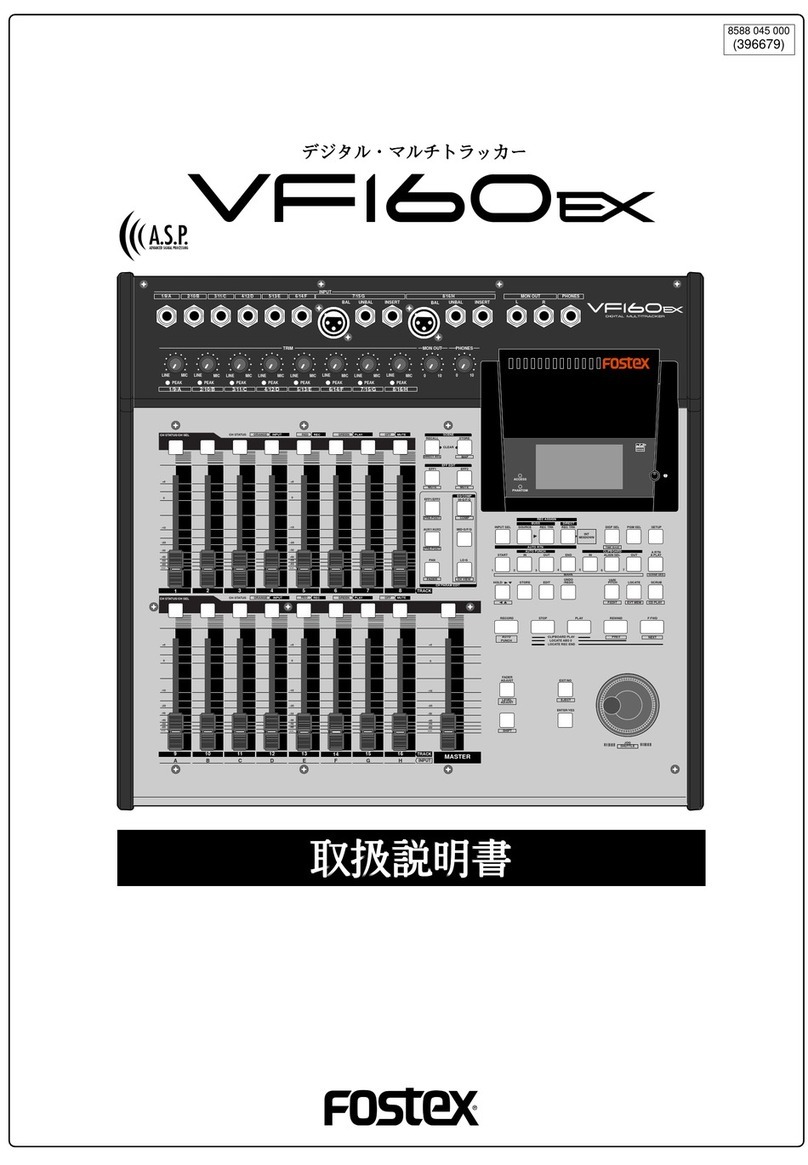
Fostex
Fostex VF160EX User manual
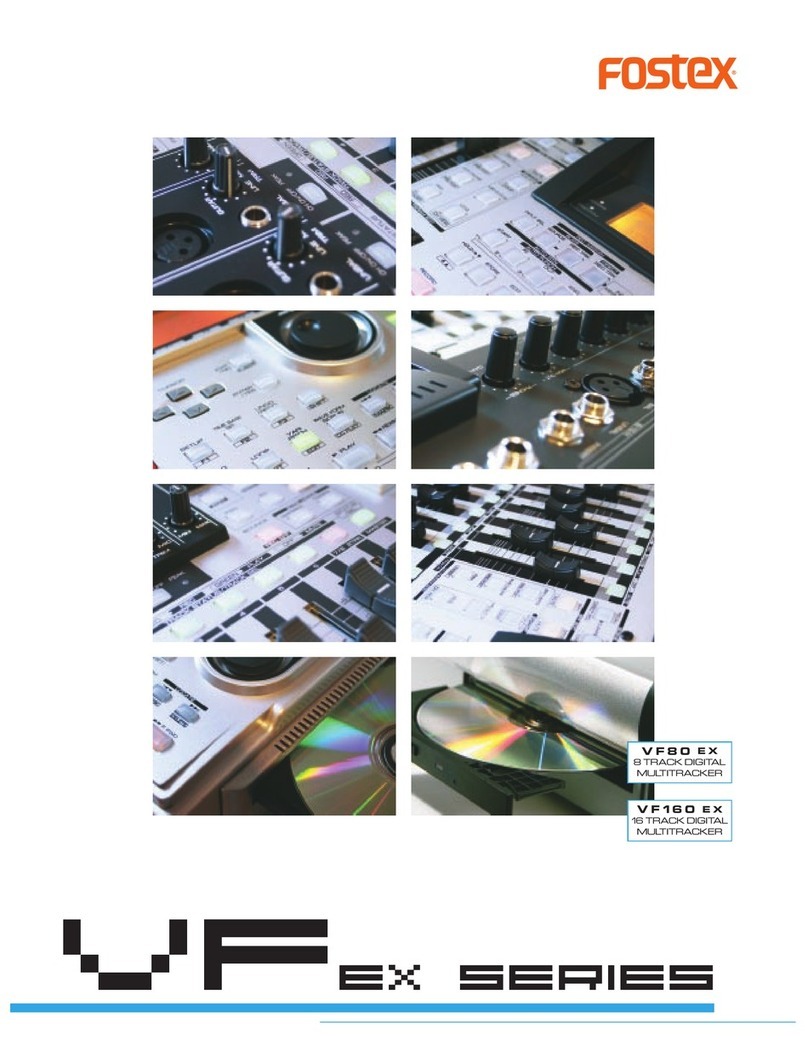
Fostex
Fostex VF160EX User manual

Fostex
Fostex G16S User manual
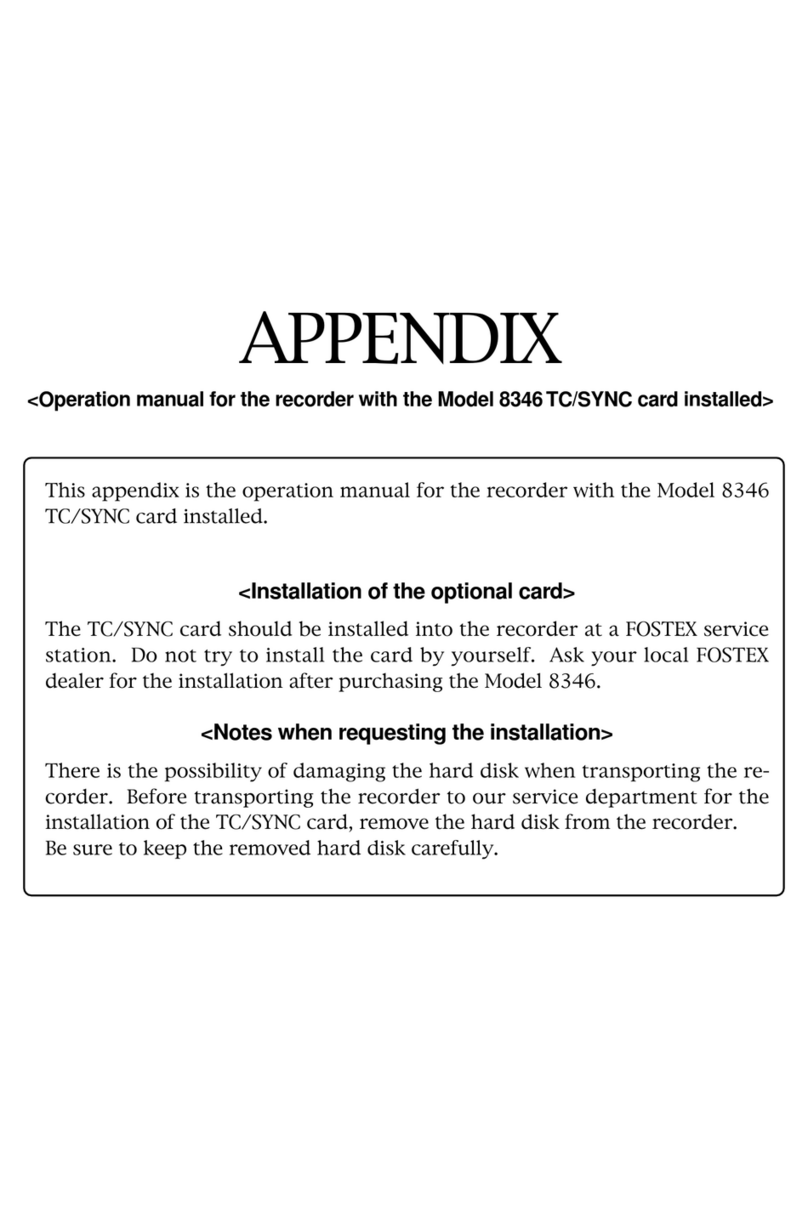
Fostex
Fostex 8346 User manual
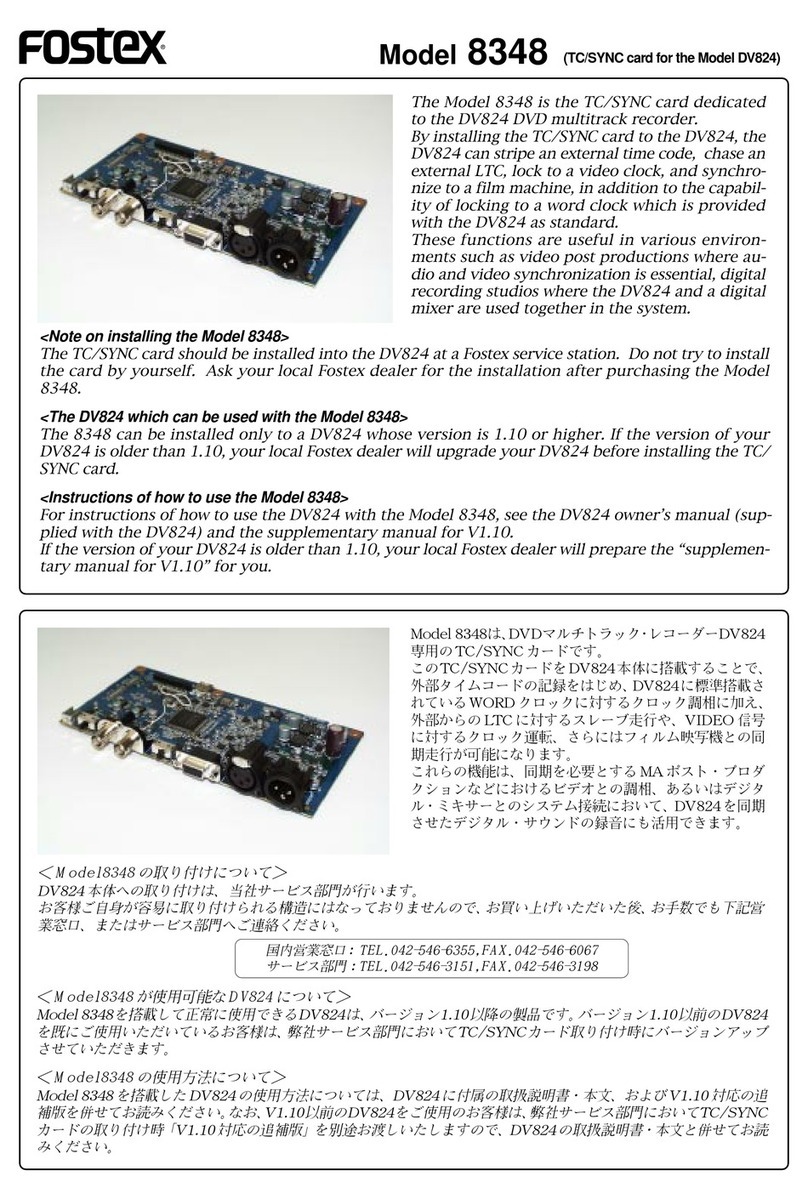
Fostex
Fostex DV-824 User manual
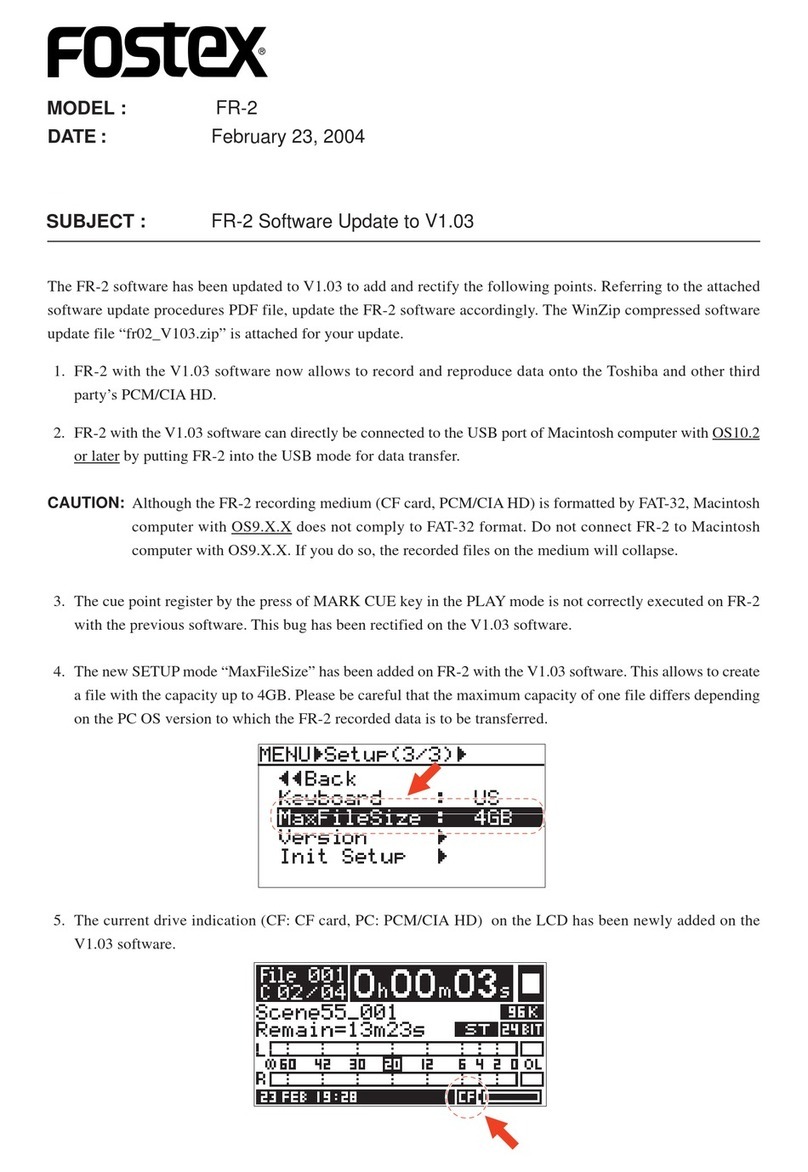
Fostex
Fostex FR-2 Technical manual
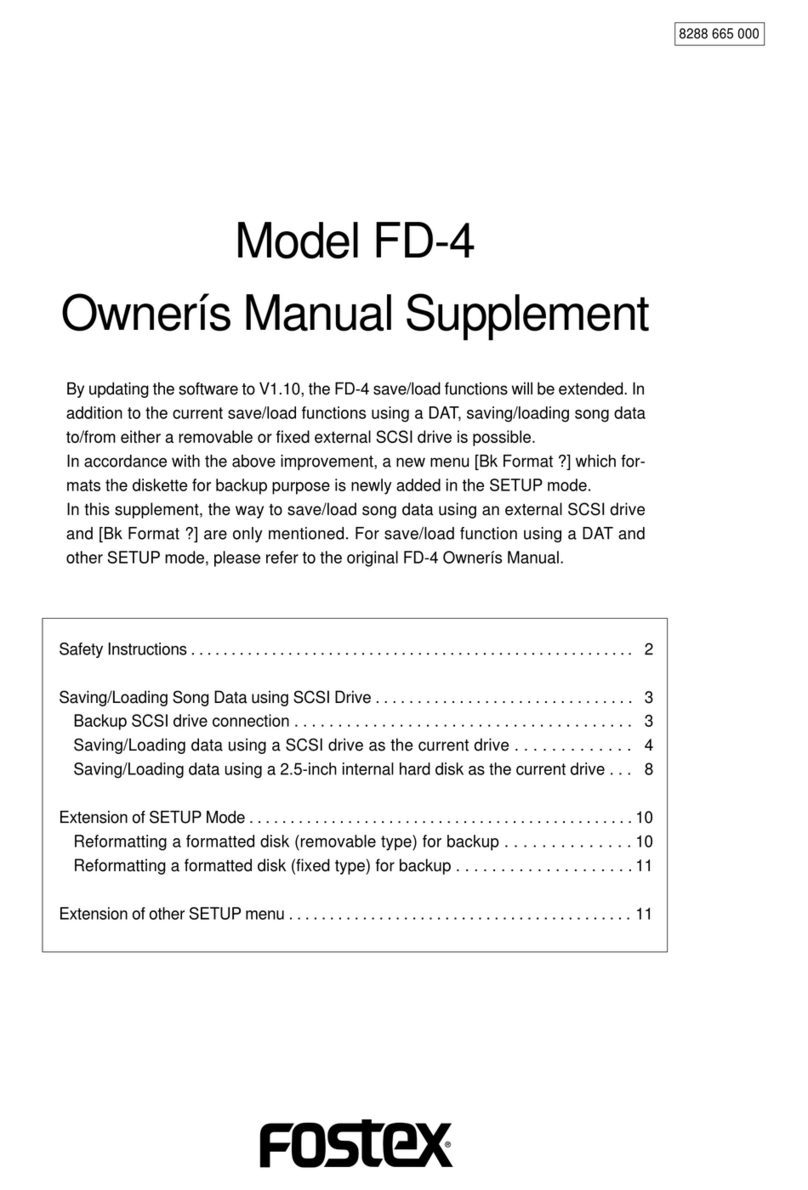
Fostex
Fostex FD-4 User manual
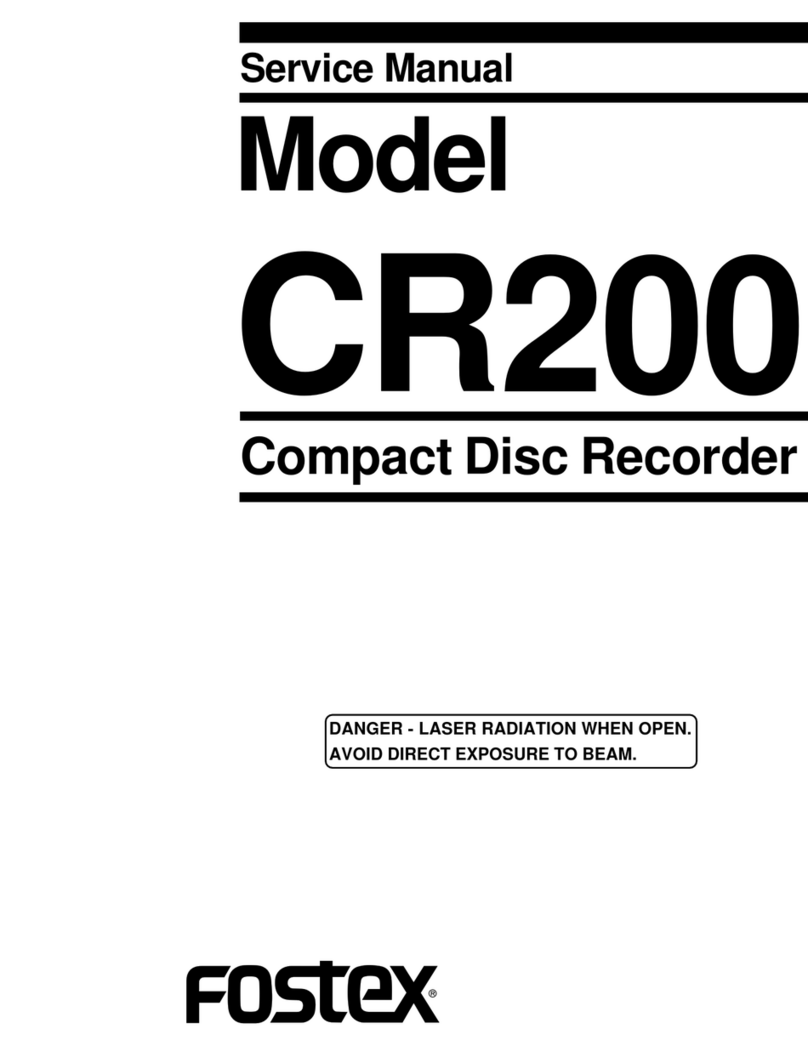
Fostex
Fostex CR200 User manual
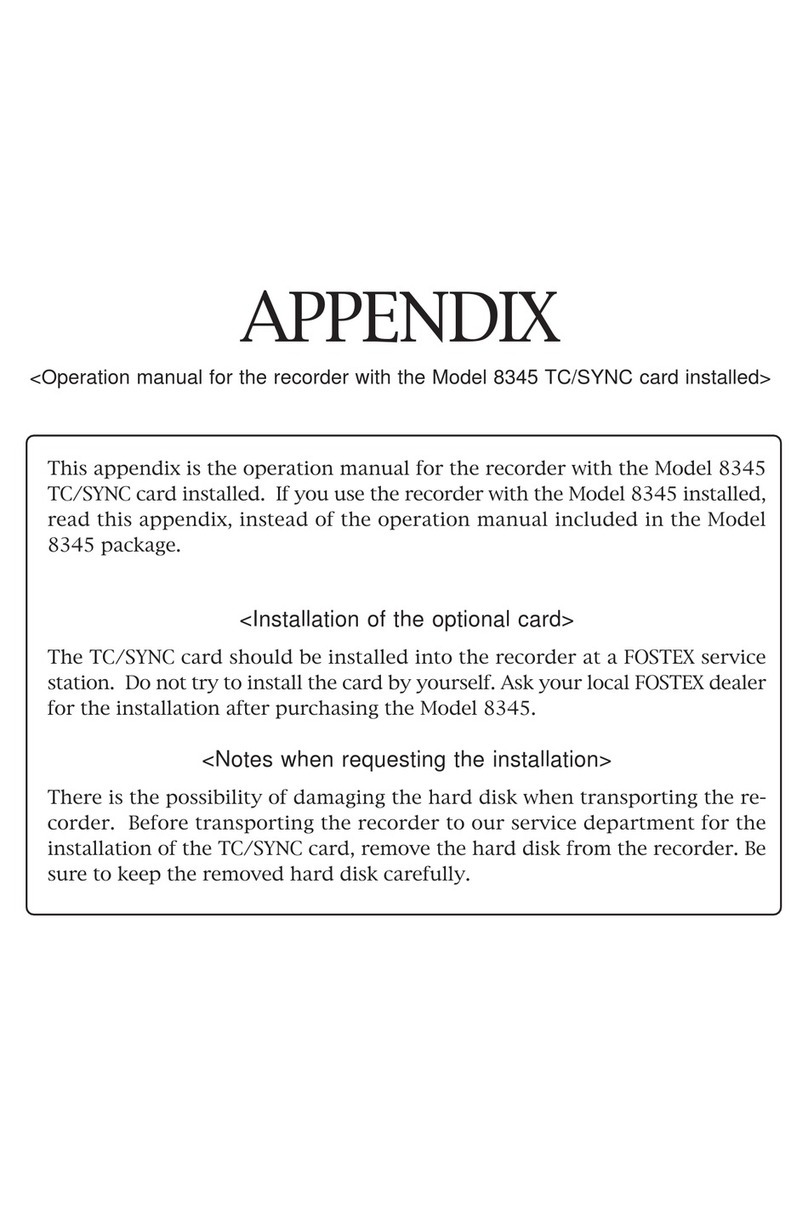
Fostex
Fostex APPENDIX User manual
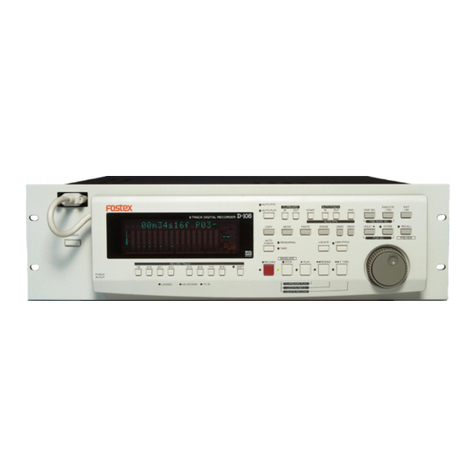
Fostex
Fostex D-108 User manual
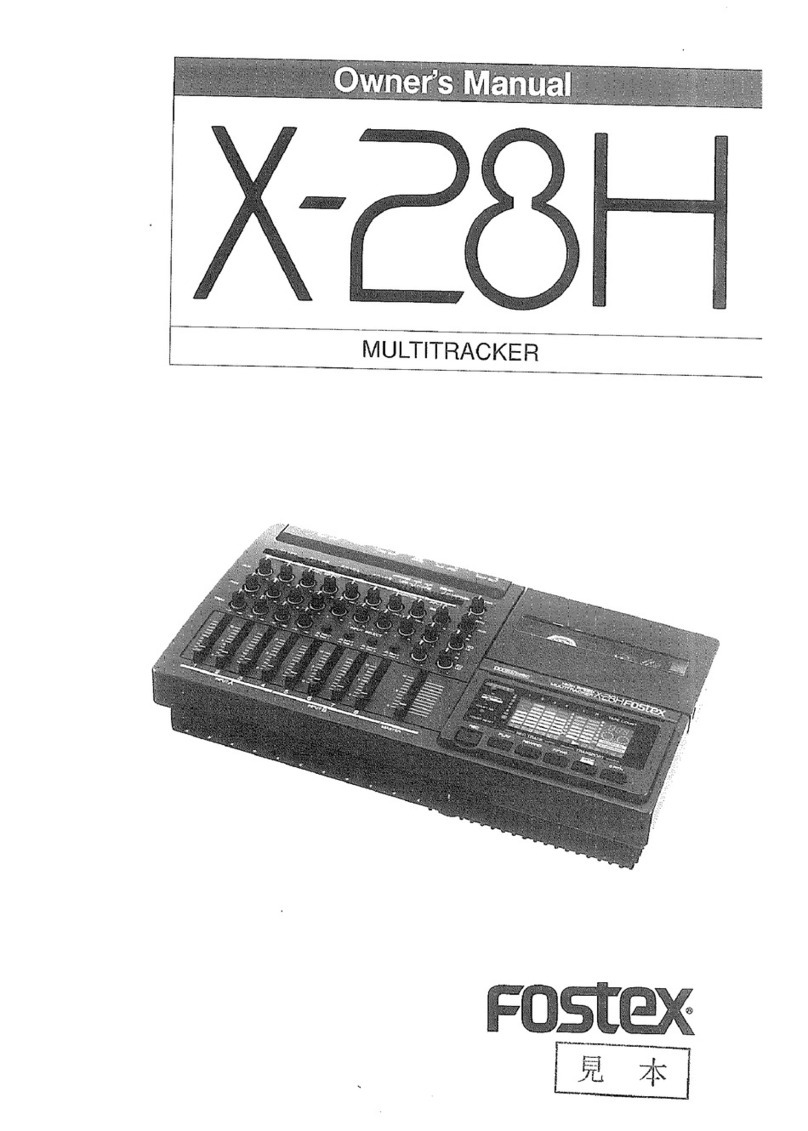
Fostex
Fostex X-28H User manual
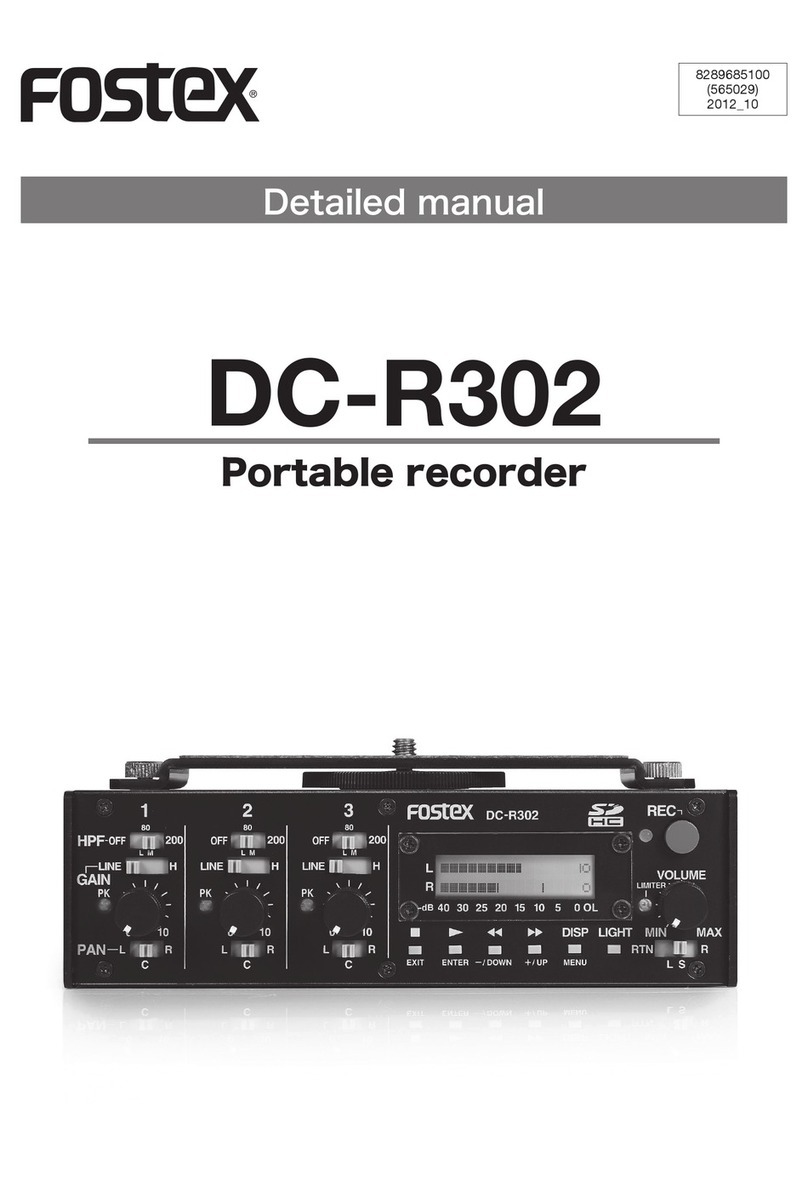
Fostex
Fostex DC-R302 Operating and maintenance manual
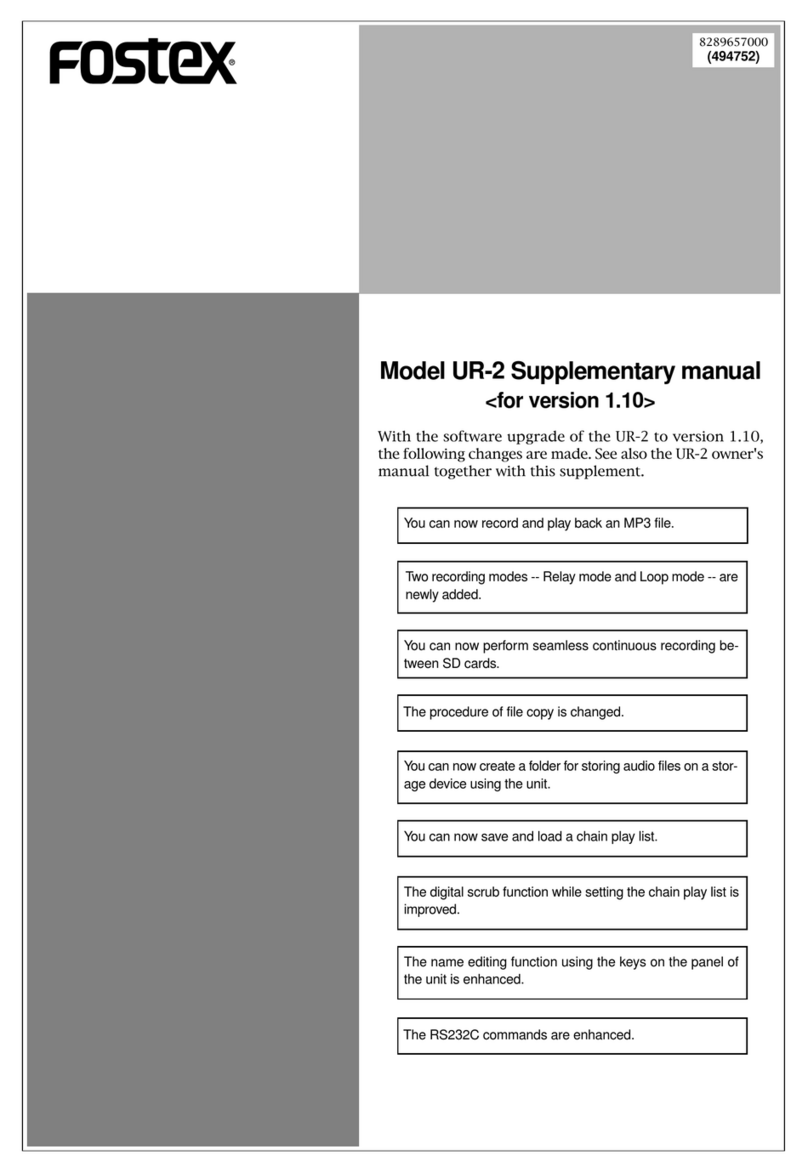
Fostex
Fostex UR-2 Instructions and recipes
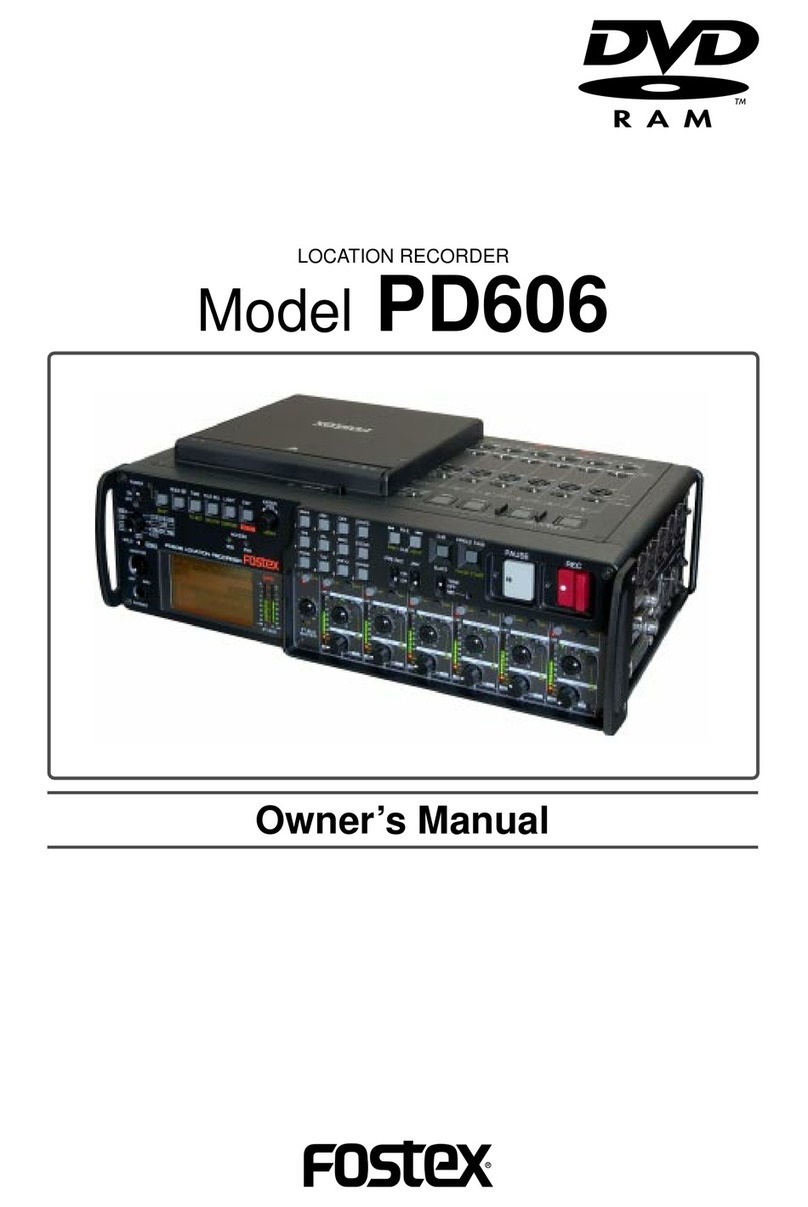
Fostex
Fostex PD606 User manual

Fostex
Fostex DV-824 User manual
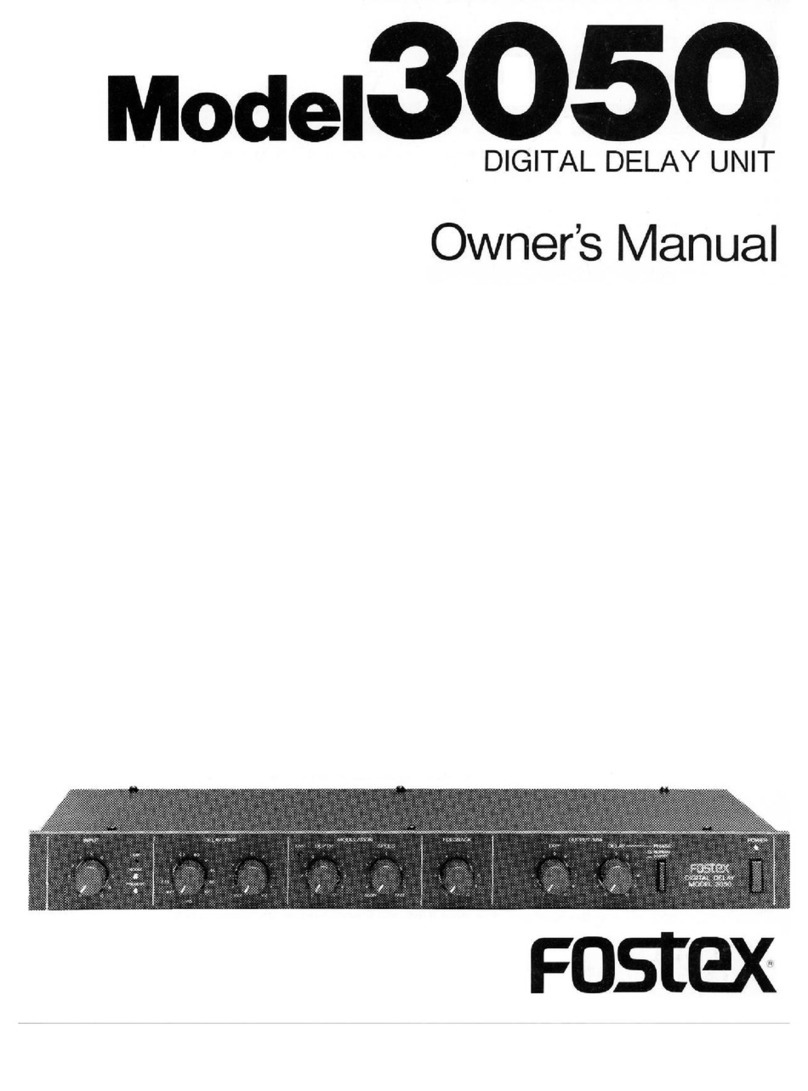
Fostex
Fostex 3050 User manual
Fostex
Fostex X-15 Multitracker User manual
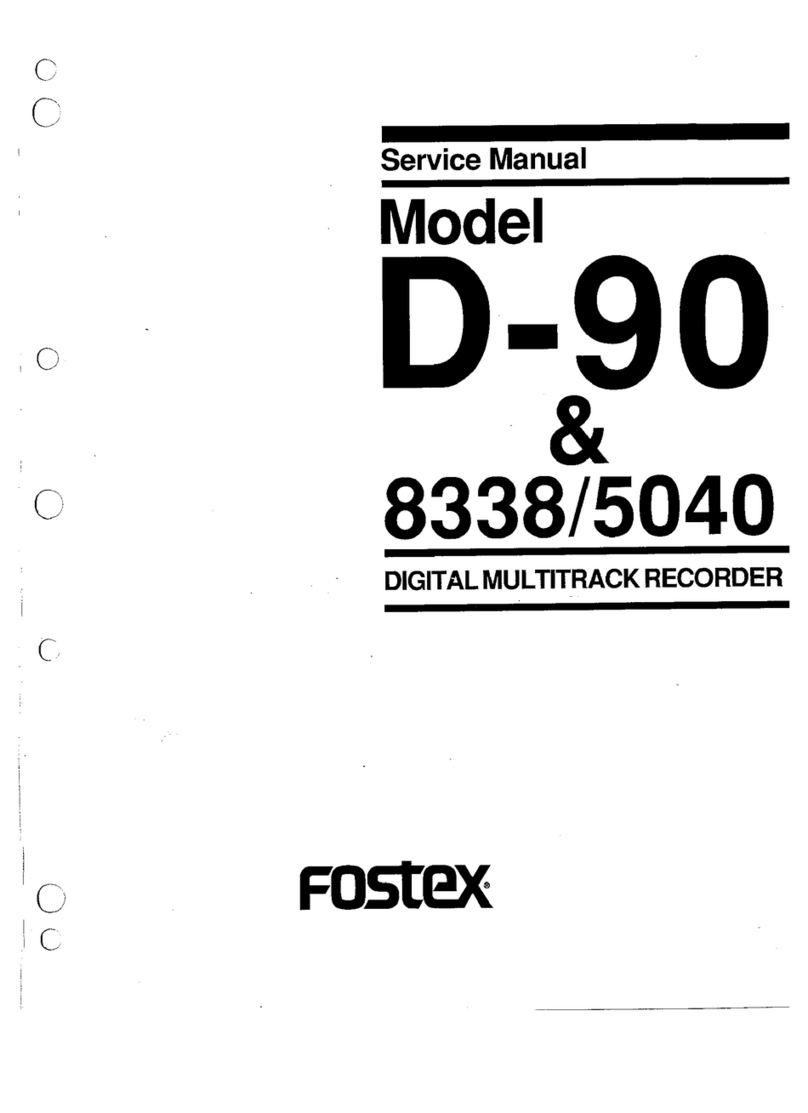
Fostex
Fostex D-90 User manual
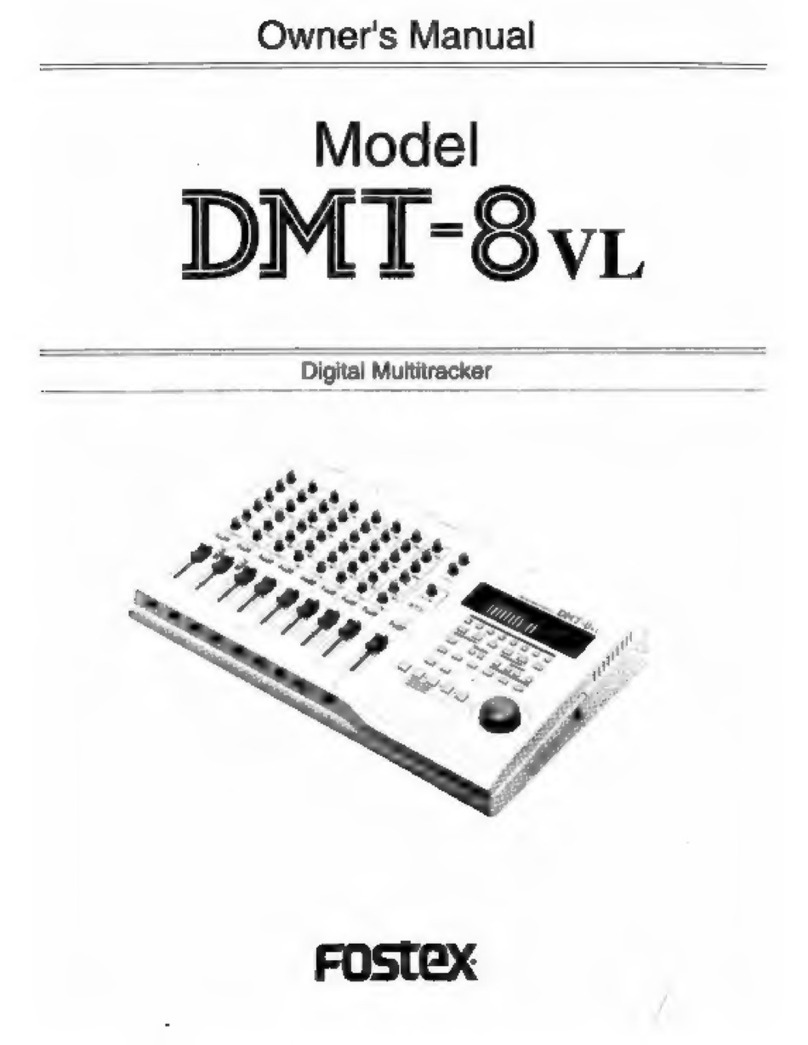
Fostex
Fostex DMT-8VL User manual
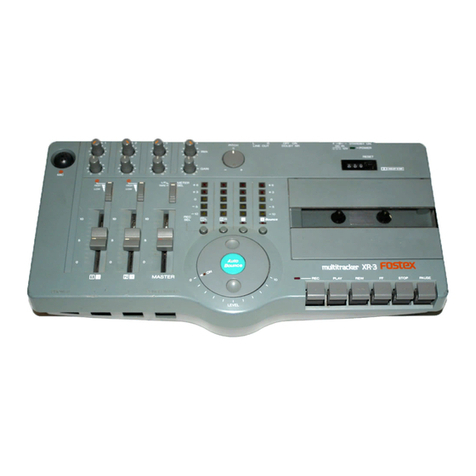
Fostex
Fostex XR-3 User manual
